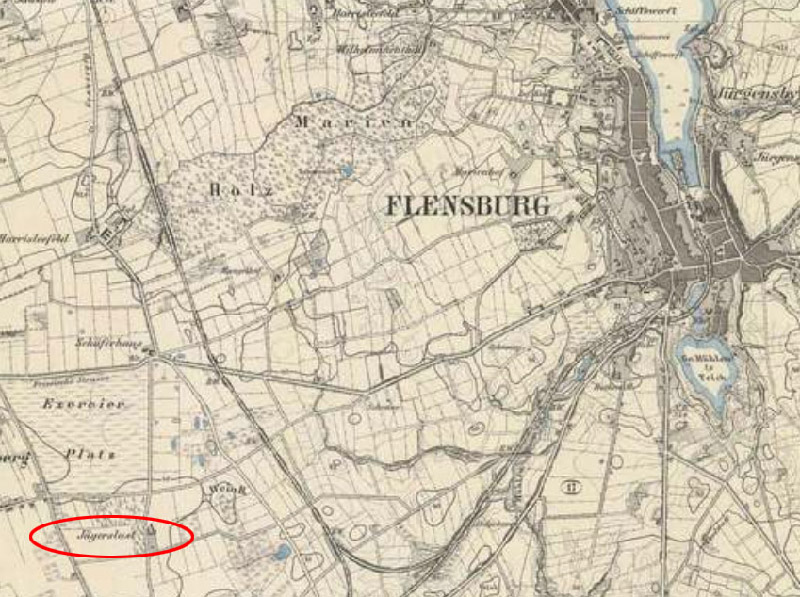Hachshara in Jägerslust, Flensburg. 1934-1938
Background
With the increasing marginalization of Jewish life in Germany under the Nazi regime, emigration became a priority for Jews who, unable to earn a living or study, could no longer picture a future for themselves in Germany. The need to escape racial discrimination and violence, coupled with a growing awareness of their Jewish identity and a lack of other possible destinations, resulted in a sudden increase in applications for Palestine among a community that had until then been largely assimilated and mostly unresponsive to Zionist ideas.
In order to be eligible for an emigration visa to British Mandatory Palestine, candidates had to be able to demonstrate skills in agriculture or crafts - skills that most hopefuls coming from urban communities did not possess. For the majority of people who wished to emigrate, so-called "retraining" was needed in order to be able to apply to such visa.
Hachshara, Hebrew for "preparation", was the term used for training programs and agricultural centers in Europe and elsewhere. At these centers Zionist youth would learn technical skills necessary for their emigration to Israel and subsequent life in kibbutzim. By 1937, the "Reichsvertretung der Deutschen Juden" (The "Reich Representation of German Jews") counted a total of thirty Hachshara centers for agriculture and horticulture, organized as communal living and working kibbutzim.
Hechalutz (Hebrew: החלוץ, lit. "The Pioneer") was a Jewish youth movement that trained young people for agricultural settlement in the Land of Israel. Initially, the German Hechalutz National Association had found little resonance among the assimilated Jews when it had first been established. It was not until 1933, when Jews started to experience their exclusion from German society, that the German Hechalutz registered an enormous increase in membership. In October 1932 there were just 589 young Jews belonging to the Hechalutz organization. By the end of 1933, that number had grown abruptly due to the increasing persecution to approximately 13,000 chalutzim across 75 local groups and various training places. At the end of 1936, there were about 8,000 members, with 96 local groups and about 60 training centers in Germany.
The people who joined the German Hechalutz organization were "generally young Jews, barely religious, far removed from Judaism, assimilated to their German environment, from a petty-bourgeois mentality and way of life. Mostly active in business, on social ascent, they were unexpectedly pulled out of their career and life path. Among them were students and young academics whose careers in higher education, medical practice, law offices, and government offices suddenly ended. [...] This young generation came from the Jewish middle class, which had been crushed since the boycott day on April 1, 1933, did not join the Hechalutz movement out of conviction. They came out of an emergency [...] They were ready to learn about the Zionist ideal, to try the way of the 'working Palestinian', to try out the unknown and to give anything a chance that seemed to promise a livelihood and stability."
One such Hachshara was on the Jägerslust estate ("Gut Jägerslust") on the outskirts of Flensburg, near the Danish border. A small facility which saw about one hundred trainees between 1934 and 1938, it was there that my mother received her training for a few short months in the summer of 1938. Thanks to this training, she would later be able to board an Aliyah Bet ("Illegal Immigration") ship to Palestine, which saved her life. Below is a brief history of the Hachshara, along with information on some of the people who received their training there.
I am indebted to Bernd Philipsen, whose research on Jägerslust provided the core of the information on this page.
The Story of Jägerslust
By Bernd Philipsen, author of "Jägerslust" : Gutshof, Kibbuz, Flüchtlingslager, Militär-Areal (Gesellschaft für Flensburger Stadtgeschichte, 2008.)
In 1906, the Wolff family, a Jewish manufacturer from Berlin, acquired the Jägerslust estate on the western outskirts of Flensburg, modernized the manor house, enlarged the stables and moved to Flensburg. The property was managed with the help of farm workers, while the father of the family, Georg Wolff, primarily pursued his passion: hunting. After his death in 1917, his widow Katharina, known as Käte, and his son Alexander Wolff continued the farm, while their daughters Susanne and Lilly trained to become teachers.
The family had already become somewhat alienated from Judaism when, after the National Socialists seized power in 1933, they experienced the effects of Nazi policies and were suddenly excluded from society and stigmatized as Jews. This development led to a return to their Judaism and the decision to make their property available to the Zionist-socialist youth organization Hechalutz as a training facility for emigration.
It can be assumed that Alexander Wolff discussed the construction and working conditions of a Hachshara farm on his estate at the Hechalutz headquarters in Meinekestraße in Berlin. Eventually, the Hamburg Hechalutz office in Beneckestraße was responsible for supporting the venture. In 1936, its director, Schimon Reich, published a report on the activities in the Hamburger Gemeindeblatt and mentioned Jägerslust, where, according to him, twelve internship or reallocation positions had begun in 1934. In view of the growing demand, he announced that capacity would be doubled: "Kibbutz Flensburg is about to expand at the moment. With the help of the Central Office in Berlin, we managed to obtain the funds for the conversion and expansion of the premises, so we have the opportunity to increase the number of chawerim to 25 in the near future."
The young men and women who completed their Hachshara at the Jägerslust estate came from all parts of Germany, namely from large cities such as Berlin, Breslau, Mannheim, Cologne, Bonn, Düsseldorf, Frankfurt am Main, Mainz, Chemnitz and Leipzig. They were more used to urban life than an agricultural milieu in the Schleswig-Holstein province. Their ages ranged from 18 to 35 years.
When the first twelve Chaluzim and Chaluzot came to the estate in the fall of 1934, they were housed on the upper floor of the manor house. To expand it, a so-called workers' house was built about 200 meters away in 1936. From now on, the Palestine pioneers, as the interns were also called, were housed separately according to gender: the women in the manor house and the men in the simple new building, where the kibbutz-like community life then took place.
The young people who lived and worked on the estate did not form a homogeneous group. Many of them changed their hachshara place after a few months in order to continue their one and a half to two year retraining or internship at another place. "There was constant coming and going," recalled Alexander Muskinsky, who spent 16 months of his Hachshara time in Flensburg and then worked in Denmark as "Madrich" [guide] in the Youth Aliyah.
The proximity to the Danish border, which was relatively easy to cross in the first few years after 1933, also spoke in favor of Jägerslust. The so-called Groschenpässe (border passes with a fee of one groschen, that is, ten pfennigs) provided good opportunities for escape and contacts to Denmark. No passport photo was required for such an identity document, which was actually intended for German-Danish excursions. The certificates were repeatedly used to undertake escapes across the border. With the introduction of the identification card on October 1, 1938, the issuance of the so-called "penny passes" was discontinued.
Finding ways into a new life was also made easier by an exchange program that had been agreed between the Landøkonomisk Rejsebureau of the Royal Danish Agricultural Society in Copenhagen and the Hechalutz headquarters in Berlin and was initially continued after the Nazi takeover. This German-Danish exchange program for agricultural apprentices gained in importance in view of the increasing pressure on the Jewish population and was promoted by both the German and the Danish Hechalutz. The Lehrgut Jägerslust also took part in this program by allowing agricultural trainees from Flensburg to switch to Danish farms relatively easily in order to continue their Hachshara there.
At the time, Gut Jägerslust was the second largest farm in Flensburg with a total of 77 hectares. It was difficult to wrest harvests from the barren, sandy Geest soil. The men, who were taught methods of soil improvement including the use of fertilizers and marl by the owner of the estate Alexander Wolff, experienced this. Machines were not used and the physically demanding work was unfamiliar and challenging for the interns. Käte Wolff looked after the women and introduced them to housekeeping. There were also practical tasks in the estate garden which was attached to the manor house. Friendships were formed and marriages formed among the Hachshara participants, who organized their own kibbutz life.
The Gestapo always kept an eye on what was happening on the Hachshara farms, including in Flensburg, where the local Gestapo chief Hans Hermannsen initially left the Jägerslust landlord and the interns alone. "He let my 'agriculture school' get away with it," said the former landlord Alexander Wolff in an interview in 1966.
The period of toleration ended in Flensburg with the November Pogrom of 1938 (Kristallnacht), when the courtyard and the kibbutz were attacked by Nazi henchmen on the night of November 10. The raid was led by the Flensburg Police President and SS Standartenfuhrer Hinrich Möller. This action, in which not only the police, but also Gestapo, SS and SA forces took part, meant the abrupt end of the grace period for the Wolff family and the Hachshara.
In its annual report for 1938, the Security Service of the North-West noted that "In the fall, the Zionist retraining camp Jägerslust near Flensburg was closed due to scandalous conditions". What the SD [Sicherheitsdienst: Security Service] report described as "scandalous conditions" was in fact the result of the attack instigated by Möller: During the night raid, all Jägerslust residents - the members of the Wolff family and the agricultural and home economics students - were arrested, some of them abused and the buildings completely devastated. The perpetrators failed in their attempt to set fire to the manor house and the stables and burn them down. They went plundering through the rooms of the main house. They showed particular interest in the family silverware and Alexander Wolff's hunting rifle. On the night of the pogrom, he managed to save himself by fleeing to neighboring Denmark. He later emigrated to the USA. He was the only one in his family to survive the Holocaust.
In the period from the fall of 1934 to the violent end of the Jägerslust emigration training center, around 100 men and women took part in the Hachshara here. The names of 75 of them are known so far, 47 men and 28 women. In 23 cases, their fate has not yet been clarified. It is reported that at least 47 people survived the Nazi persecution. Most of them - namely 31 - made Aliyah and went to Palestine; five found refuge in the United States.
The Jägerslust estate, which was orphaned after the attack during the pogrom night in 1938, was "Aryanized". Buildings and land became the property of the state treasury, which used it to expand the neighboring Flensburg-Schäferhaus airfield in view of the approaching Second World War. After the end of the Second World War and the collapse of the Nazi regime, the manor buildings, supplemented by several simple barracks, functioned temporarily as emergency accommodation for refugees and expellees from the Eastern German territories.
For several years, Alexander Wolff had to fight from the USA with the help of German lawyers for compensation for the former family property in Flensburg. The proceedings ended in 1952 with a settlement: financial compensation totaling 75,000 marks for buildings, lands and lost inventory.
The former estate remained in public hands - until today. The Bundeswehr used it as a military training area. The once stately mansion was blown up in 1967 as part of an exercise. The Jägerslust story finally came to an end when the Schleswig-Holstein Nature Conservation Foundation, which had taken over the site from the Bundeswehr in 1998, had the last stable building demolished in 2004. Following a suggestion from local citizens, the city of Flensburg had an information stand set up on the edge of the former estate. It provides an overview of the eventful, tragically ending history of the estate in text and images.
Nature has reconquered this piece of land. Wildflowers and grasses have settled in crevices of remaining foundations. Raspberries and nettles grow rampant in the former house garden. Today, a peaceful stillness lies over the site, as if destinies had never been decided here and life paths crossed like those of the young Palestine pioneers, for whom the Jägerslust estate was a place of hope, as was the case during the Hachshara period.
Bernd Philipsen
Gut Jägerslust, Flensburg.
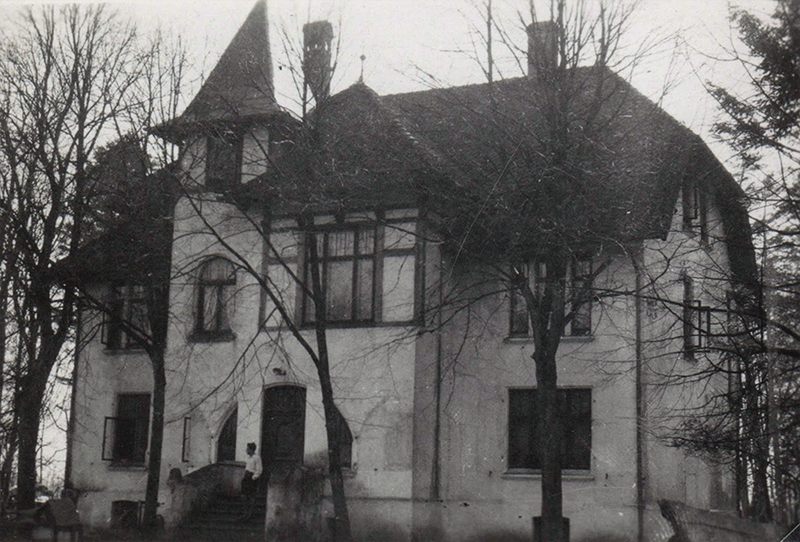
The front of the manor house of Gut Jägerslust. The young women lived upstairs.
Photo: Richard Hausmann, courtesy of Eric S. Hausmann.
"The manor house was three minutes from the kibbutz. To get there, you walked through a beautiful tree-lined avenue, past fields and pastures. The manor house was in the middle of a courtyard. On the right lay the threshing floor and the pigsty. As well as granary and tool shed. On the left the cow, horse and hen house; on top came the hay, straw, etc. "
"Behind it was the manor house's laundry room, the potato steamer and a toilet. The manor house was fabulous, very large. In the basement there were many rooms for the vegetables to overwinter, a centrifuge and a pump system. Everything was electric here. On the ground floor were the kitchen, anteroom, hallway, 3 living rooms. On the first floor there were 5 bedrooms, a bathroom, closet and 1 huge hallway, a door led to the W.C. Then you went up a flight of stairs and you were on the floor with lots of doors. Three of them led into the girls bedrooms. Behind the others was the pantry. Otherwise junk and the pump chamber in which the two water tanks were."
Excerpts from Lilli Marie and Anne Rose Dreifuss's letter describing their time in Jägerslust in a 10-page letter to a friend in February 1939.
The young women slept in three rooms in the manor house. According to this letter, there were 10 girls living in the Hachshara by November 1938. Four girls slept in one room meant for three, another four in a second room, and two more slept on couches in the last room.
"First the room in which [the Dreifuss sisters] slept. [Towards the end of their stay], there were 4 occupied beds, 1 small closet that served as a washbasin, which hid our hairdressing and shoe shine stuff below. A linen chest of drawers, 1 wardrobe and 1 small table that served as a bedside table. 2 of these beds were on top of each other. It was otherwise only a triple room. "
"In our largest room with 3 windows there were also 4 beds. 2 on top of each other, 3 chairs, 1 vanity, 1 stove and a box as a bedside table. In the last and most beautiful room there were 2 couches that served as beds, 2 cupboards, 1 table and 1 stove. The two bedrooms were heated. There were also 3 cupboards on the floor for our things and our suitcases."
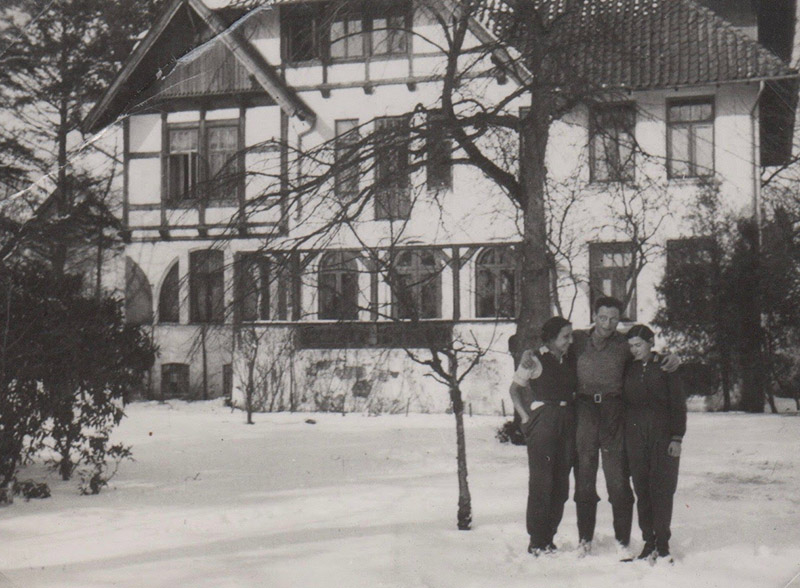
The back of the manor house of Gut Jägerslust. Erna Weinert, Richard Hausmann, Jenny Jaschkowitz. January 1937.
Photo: Richard Hausmann, courtesy of Eric S. Hausmann.
The "Kibbutz"
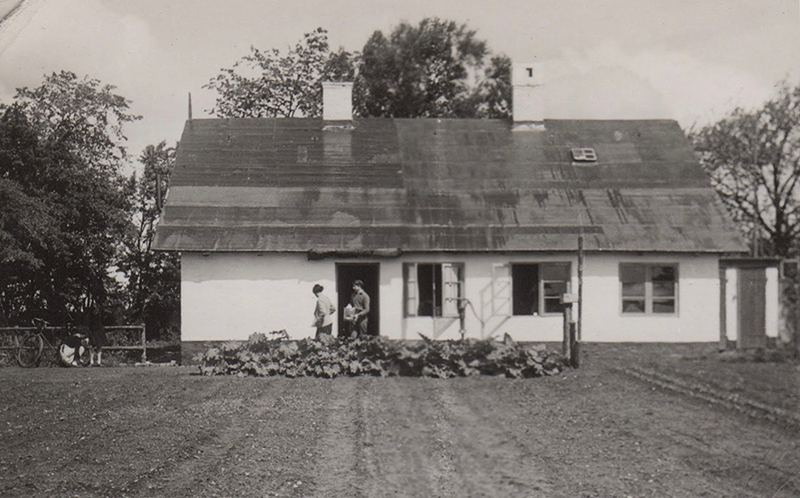
The workers' house, or "Kibbutz", where the young men lived.
Photo: Richard Hausmann, courtesy of Eric S. Hausmann.
Two sisters, Lilli Marie and Anne Rose Dreifuss described their time in Jägerslust in a 10-page letter to a friend in February 1939. Below are some excerpts.
They first described the "Kibbutz", the building where the young men slept and where communal activites took place:
"In Flensburg we experienced fabulous hours, days, weeks and months [...] Imagine, everything as primitive as possible, oh no! Much more primitive!! Our kibbutz! A long wooden barracks. Whitewashed with a black roof. When you came in, straight into the kitchen on the ground floor. Stone floor, gray, low, heavy, raw kitchen cabinets, two pieces and a pantry with fly wire in front of all walls carpentered by a 'Chaver' himself [...] We also had a stove in the kitchen and hooks for the kerosene lamps everywhere. [...] Straight ahead you came into the dining room, this [room] was until very recently used for different purposes, because later we also got a living room. In this very small room, one wall was painted with oil, there was a couch to sit on, if needed and available, also 2 chairs, 1 table and a small round and 1 cupboard. A self-adhesive picture hung on one wall, with a palm tree, 2 camels and drivers; on the other wall was a palm tree, a worker with... and a ship, also painted by this same boy. He was a wrestler, poster artist, salesman and, like all of us, an agricultural trainee... "

Celebrating with a wreath the inauguration of the Jägerslust "Kibbutz" which was completed that month. March 22, 1936
Standing, 4th from the right: Lotte Wald.
Photo: collection of Richard Hausmann, courtesy of Eric S. Hausmann.

Erna Weinert and H. Finkelstein on the roof of the "Kibbutz".
Jägerslust. March 22, 1936.
Photo: collection of Richard Hausmann, courtesy of Eric S. Hausmann.
"A 'laundry room' was also located inside this very spacious barracks, on the ground floor. In it stood a large washing oven. On the walls hung 4 tubs and brooms. 2 washing kettles, washboards and trestles were also in there. Now there was still space in the size of a square meter. When the weather was nice we washed outside, and otherwise in the kitchen. We washed with 2 or 3 girls. If there weren't that many, 1 boy helped out. In bad weather, the laundry was dried on the floor. It was above all the rooms described so far. It was accessed by a 'chicken ladder' built into the top of the door, and it took some routine to balance up and down it with a full tub. Cords were stretched quite tightly on the floor, then there was another mangle for mangling the bed linen and towels."
"Boxes, suitcases, old bikes, old shoes and old beds were also on this rain-permeable upper floor. It was raining in our kitchen. [...] Attached was a smaller barracks in which the two toilets and the coal shed were. Bikes were stored here if they were still usable. "
"The triple room already mentioned served as a washroom in winter. In the summer it was in a shack that was lined with tin. Size 5 square meters. In it was a long table with about 5-6 washbasins for the 15 boys. Above it was a shelf for the wash things, divided into compartments. Underneath on a pole was the bowl for the feet and the box with the shoe polish kit. Then there was a huge chest for the dirty laundry, the cobbler's table; When the weather was nice, we worked outside, otherwise in the washroom and in winter in the dining room. Approximately every 1-2 months 8-14 days. Bikes, boxes and our kerosene lamps were also in there. "
" Our 7 kerosene lamps enjoyed general popularity. At table they were all in the dining room and if you were still sitting there afterwards, it could happen that you suddenly found yourself in the dark when others had kidnapped them into the other 5 rooms. With long fights and discussions you could get one back for sometimes 10 people."
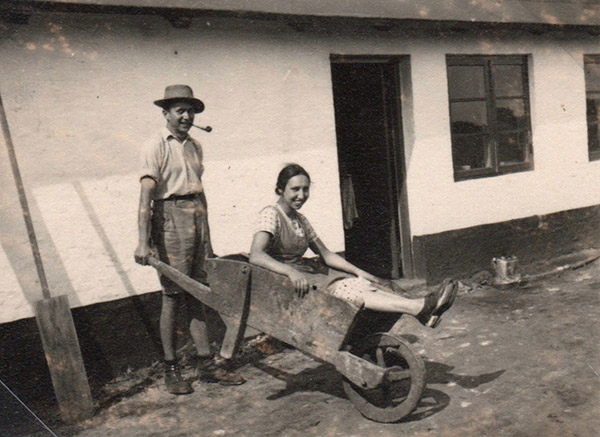
Felix Bender and Erna Weinert in front of the entrance of the "Kibbutz". March 22, 1936.
Photo: collection of Richard Hausmann, courtesy of Eric S. Hausmann.
"Meusche-Cusev (?) - our loo [...] consisted of two cells separated by a wall. On top a board with a hole and a lid, underneath a bucket whose contents had to be buried in the potato field by the respective kitchen boy every week. [...] Mostly with big procession, flowers, green etc. When we planted the potatoes, we found the remains, some of which had not yet decomposed, in the affected areas."
"In front of the house there was a pump, from which every drop of water had to be pumped out yourself; however, all our boys were gentlemen, if they saw us at the pump, it was a matter of course for them to pump for us. We didn't have running water in the kibbutz, except when it rained, when it ran. However, the water ran down the walls. But we didn't do anything about it, we couldn't help it!"
"At the back and side of the house was a small strip of flowers in the garden. In front of the house we had a piece of land with potatoes and all kinds of vegetables, such as: carrots, beans, peas, beetroot, parsley roots, dill, savory etc. Opposite, just across a wide path, we had another piece of land, cultivated in the same way. This was surrounded by a forest."
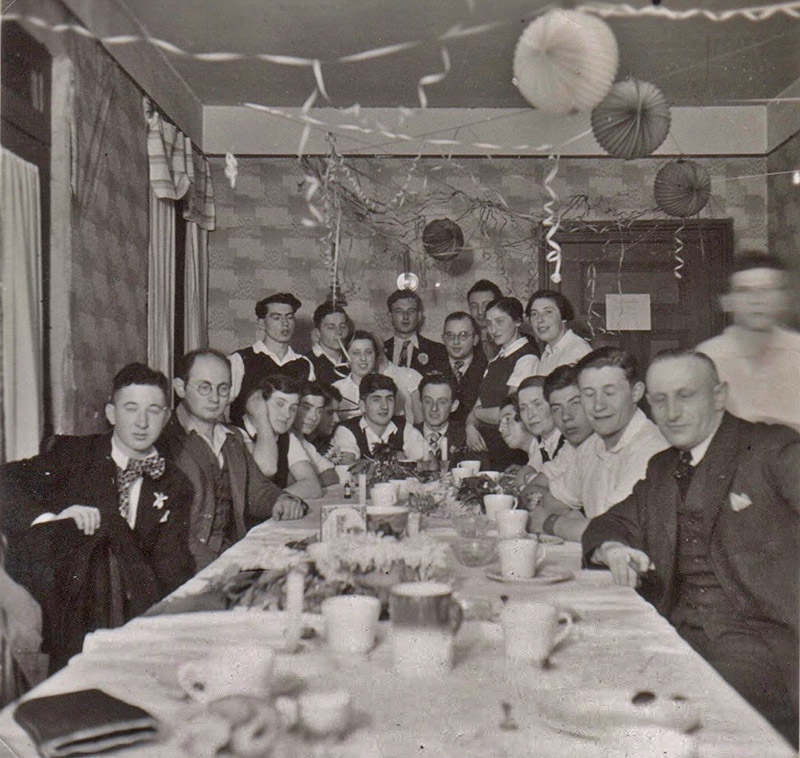
Oneg Shabbat, October 16, 1936. Twenty-one interns are gathered around the table for the Shabbat dinner in Jägerslust.
Photo taken by Willi Friedmann. Collection of Richard Hausmann, courtesy of Eric S. Hausmann.
"The living room, called Cheder-Sheket (quiet room), where most of the time there was the biggest noise, used to be the so-called triple room. So named because only three boys slept in it, making it the smallest boys bedroom. Our dining room, Cheder-Ochel, was our largest. It had three knee-high windows, a door, half glass but always locked, facing the street. Everything with Swedish linen blinds to close and curtains. In the middle was a long table made of three tables, a brown checkered oilcloth over it. Against one narrow wall stood a bookcase full of books, part property of the kibbutz, part property of individual chaverim and chaverot, a typewriter table and a "billboard" from K.K.L. hung there. Along one of the long walls stood a small, low cupboard on which the pots for serving food were placed. Above it hung a photo of Herzl and a photo of Bialik."
"Then there was the front door to the kitchen where the dishwashing schedule was attached, a different one every week. Every night a different boy and girl had to do dishwashing together, and the door to a boy's bedroom was on the same wall. On the second narrow wall was the door to the laundry room. We also had 5 more or less long, very stable benches made by our landlord. Depending on need and availability, you could also get the two chairs. In the linen room, in front of the longest wall, most of the space was taken up by a comfortable double linen closet. A table, sewing machine and chest completed this one-window room. So there was still room for one to stand, but we have already ironed, sewn and darned five in it."
"The two boys' dormitories were back-to-back. Six boys slept in the front. There were two beds on top of each other. In the back room there were seven beds, 2 times 2 one above the other, 3 on 1 floor. Between the beds there were always 'bedside tables' consisting of one or two boxes placed one on top of the other. In the first bedroom there was a very nice plywood wardrobe. All floors were plain planks, and like in the other rooms, they were scrubbed almost snow-white every Friday."
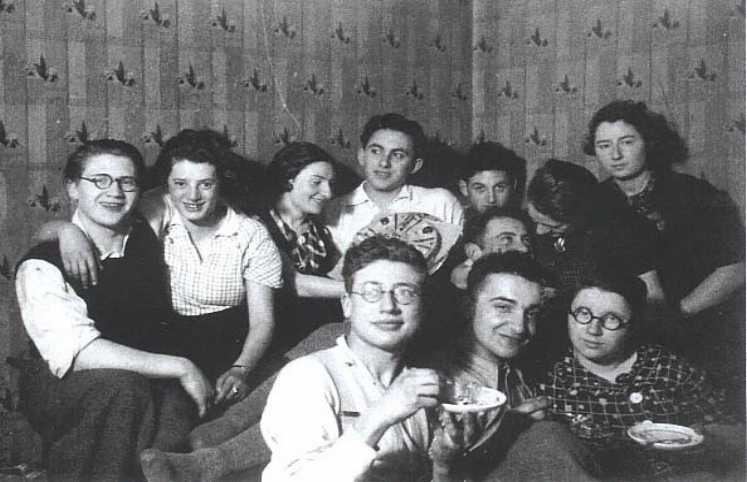
Erwin Linz (left row) with other Flensburg trainees, ca 1935
Photo (c) courtesy of Bernd Philipsen.
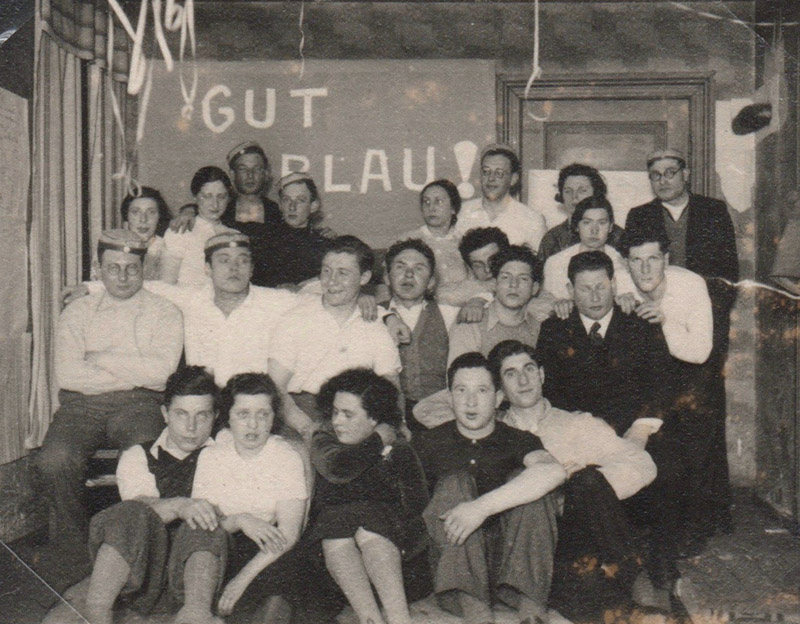
"Blaumacher Association", March 1937
Photo taken by Willi Friedmann. Collection of Richard Hausmann, courtesy of Eric S. Hausmann.
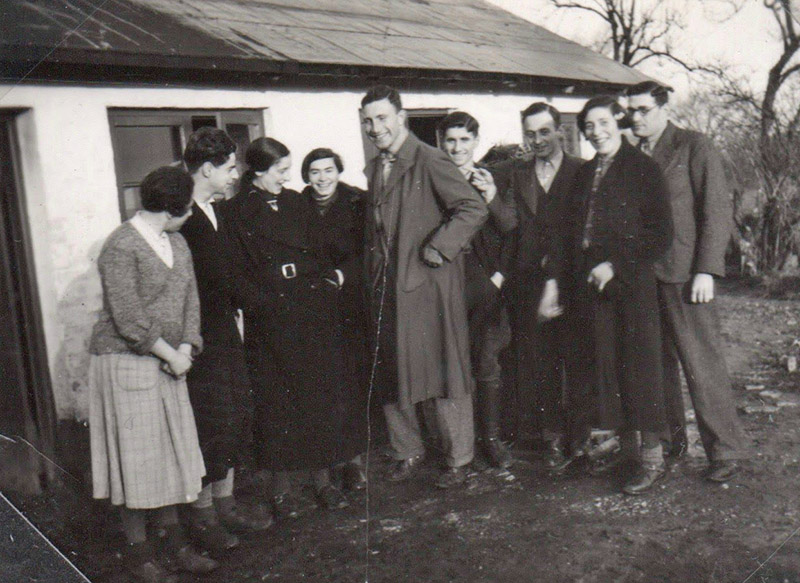
Group with Yehuda Marcus (center) in front of the "Kibbutz". December 17, 1936. Ruth Hamburger second from the right.
Photo: collection of Richard Hausmann, courtesy of Eric S. Hausmann.
Photos of Hachshara life in Gut Jägerslust, Flensburg.
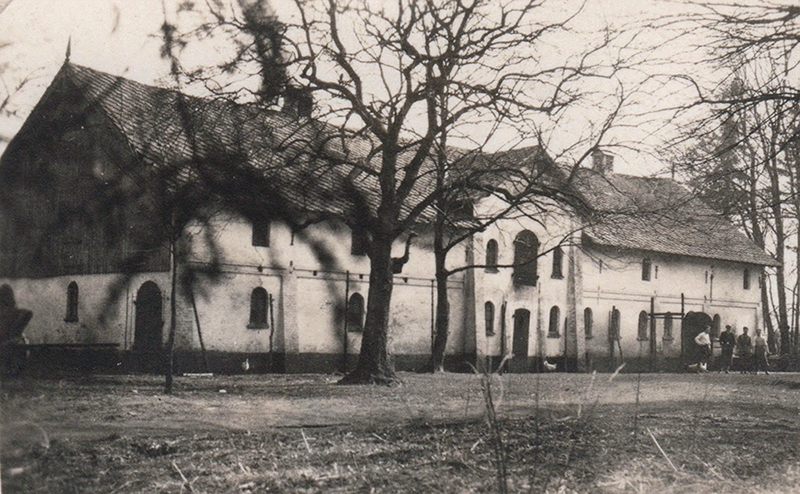
One of the two stables of Jägerslust, which housed cows and horses, 1936.
Photo: Richard Hausmann, 1936. Courtesy of Eric S. Hausmann.
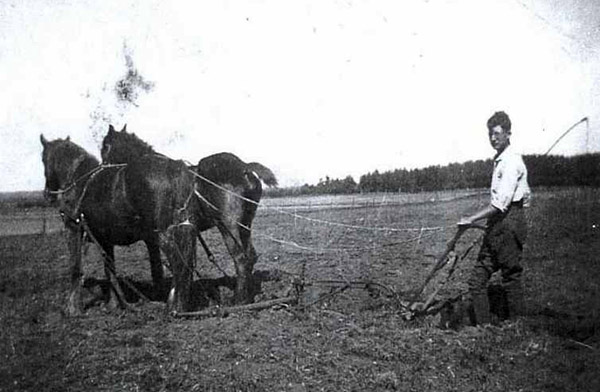
Erwin Linz behind the plow, 1935-1936
Photo courtesy of Bernd Philipsen.
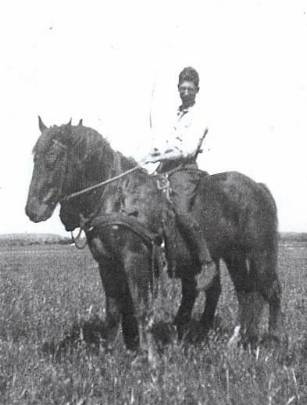
Erwin Linz, Flensburg 1935-36
Photo courtesy of Bernd Philipsen.
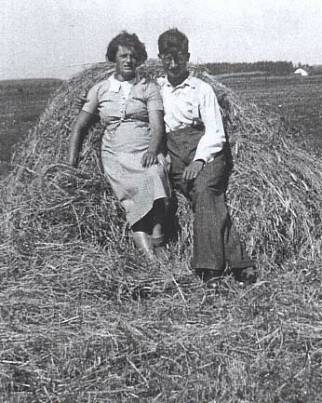
Erwin Linz, Flensburg 1935-36
Photo courtesy of Bernd Philipsen.
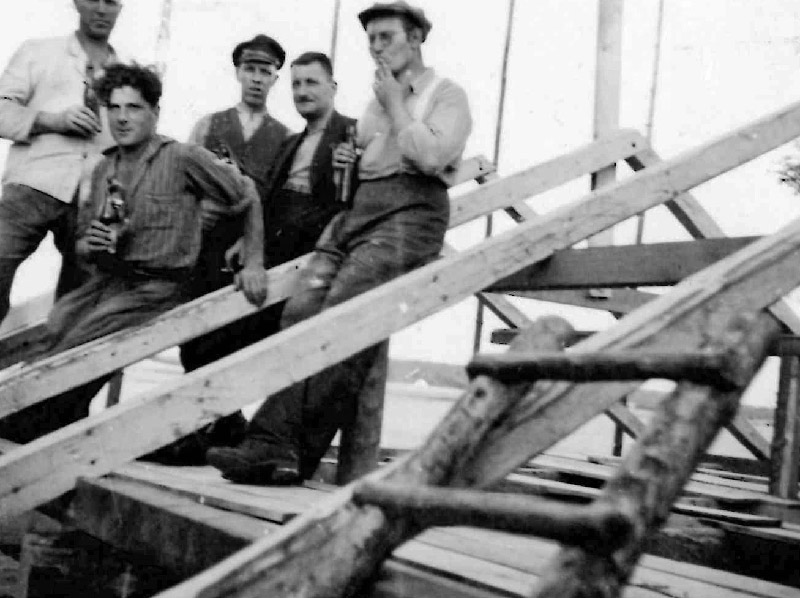
Probably early March 1936. A new building (the kibbutz) had to be added to support the expansion of the Hachsharah program, as the number of trainees in Jägerslust doubled. This photo shows the structure of the roof being erected. Second to the right is Alexander Wolff. The man to the far right may be Josef Lustig. The others may be artisans from the city.
Photo: collection of the Lustig family. Notes: Bernd Philipsen.

Hachshara group on the edge of the forest, Jägerslust, Flensburg. 1936-1937.
Alexander Wolff, Erna Weinert, Frau Käte Wolff, Chaim (Hermann) Berger, Gerhard Cheim, Adi Sporn, Josef Lustig.
Photo collection of Richard Hausmann, courtesy of Eric S. Hausmann.
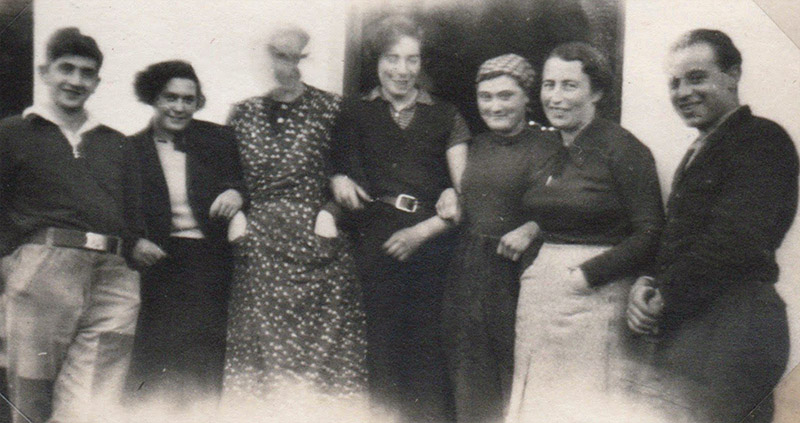
Hachshara group, Jägerslust, Flensburg. November ? 1936
(?), Friedel (Peterseil?), Margot, Ruth Hamburger, Erna (or Eva?), Herman xxx , Paul
Photo collection of Richard Hausmann, courtesy of Eric S. Hausmann.

Hachshara group in front of the stables, Gut Jägerslust, November 5, 1936.
Richard Hausmann, Ben, Lotte Kaiser, Ernst Isaksohn, Frau Käte Wolff, Ferdinand Ehrenberg, I (?) Leiter, Max Klausner
Photo Collection of Richard Hausmann, courtesy of Eric S. Hausmann.
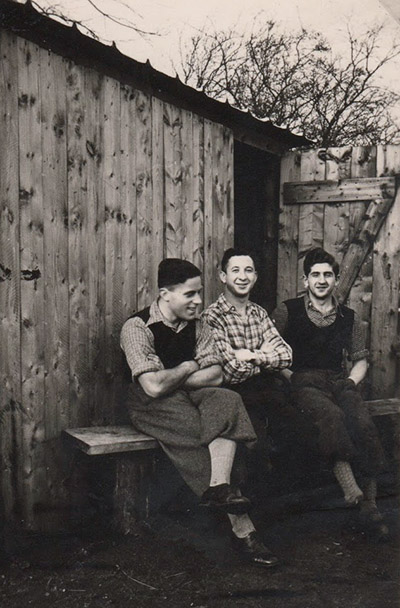
Franz Kaufmann, Hermann (Chaim) Berger, Adi Sporn, 1936-1937.
The "Mikve Israel" group who wanted to go to Israel together to the agricultural school Mikve Israel.
Photo Collection of Richard Hausmann, courtesy of Eric S. Hausmann.
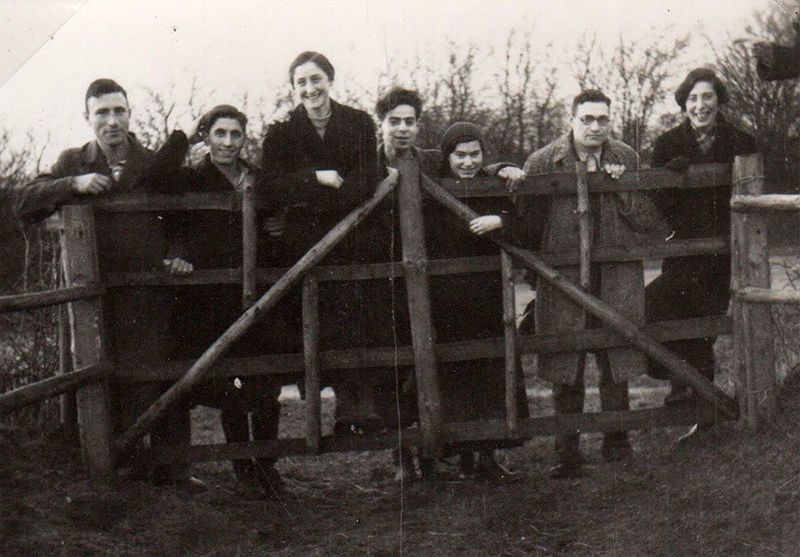
On the way to Padborg (Denmark) with Yehuda Marcus (left), December 1936. Far right: Ruth Hamburger.
Photo by Willi Friedmann, Collection of Richard Hausmann, courtesy of Eric S. Hausmann.

Hachshara group with Yehuda Marcus by the edge of the forest in Jägerslust, Flensburg. 1937.
Photo by: Ferdinand Ehrenberg. Collection of Richard Hausmann, courtesy of Eric S. Hausmann.

Group with Kurt Wohl in front of the sheds. January 7, 1937.
Photo: collection of Richard Hausmann, courtesy of Eric S. Hausmann.
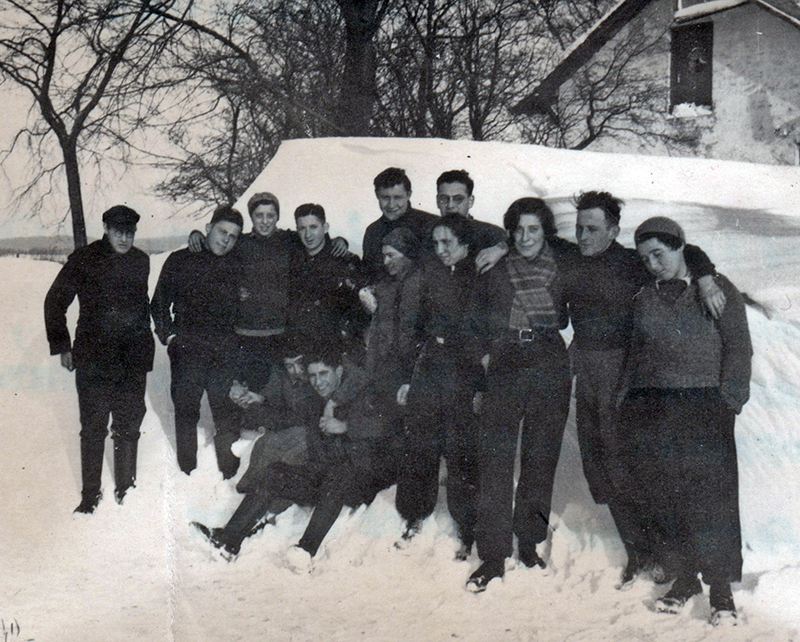
Kibbutz Jägerslust, Flensburg. January 16, 1937
From right to left: Lotte Kaiser, Bernhard (Männe) Horn, Ruth Hamburger, Richard Hausmann, Erna Weinert, Ben ..., Jenny Friedmann, Chaim (Hermann) Berger, Berta Tokajer, Franz Kaufmann, Ludwig Lilie. Sitting, front row: Fritz Plaut & Trude Leiter.
Collection of Richard Hausmann, courtesy of Eric S. Hausmann.
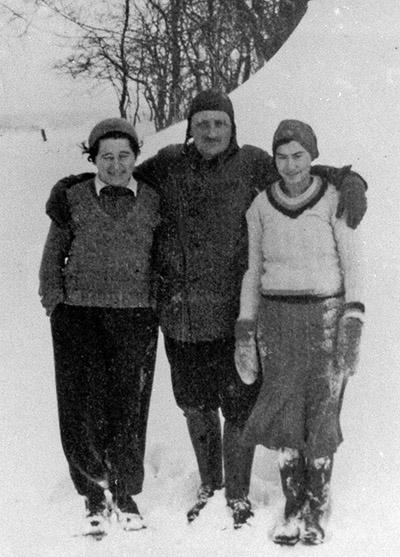
From left to right: Lotte Kaiser, Alexander Wolff and Jenny Jaschkowitz.
January 1937.
Photo courtesy of Bernd Philipsen
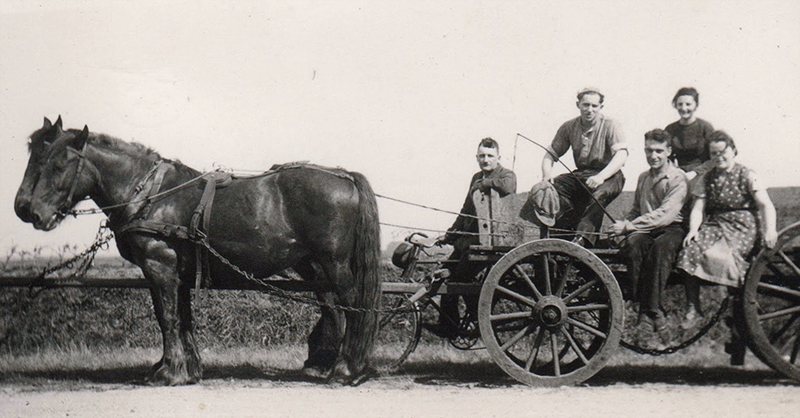
In the fields with a horse-drawn carriage, accompanied by Alex Wolff on a bicycle. 1936-1937.
Photo: Collection of Richard Hausmann, courtesy of Eric S. Hausmann.
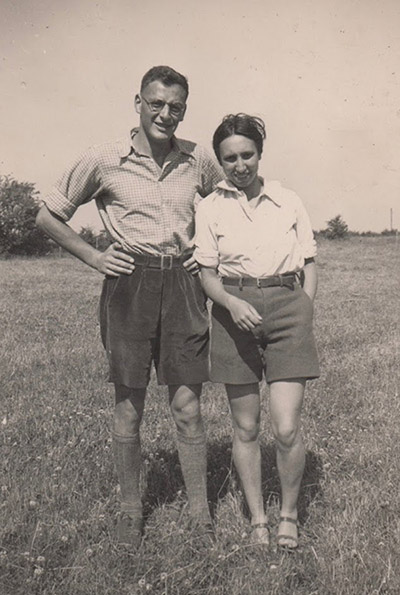
Richard and Erna Hausmann, 1937
Photo: Collection of Richard Hausmann, courtesy of Eric S. Hausmann.
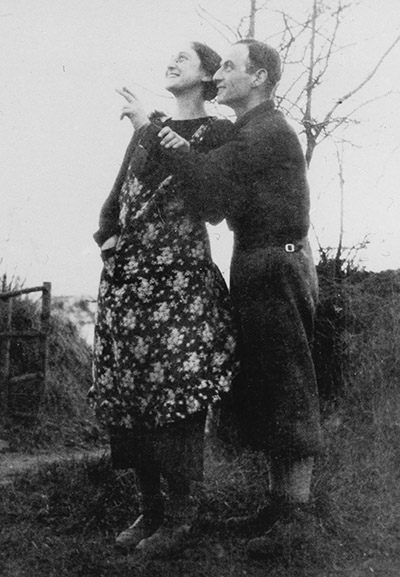
Bernhard and Margot Horn
Photo courtesy of Bernd Philipsen.
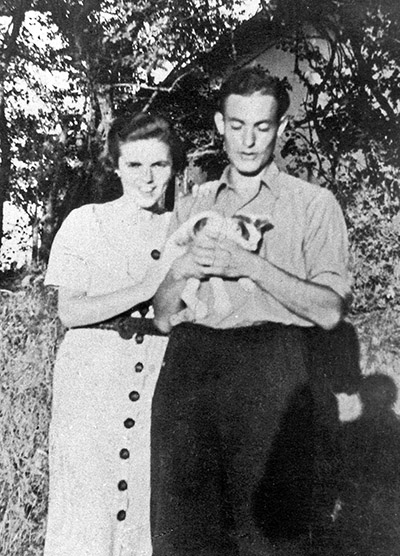
Regina Nadler and Max Woislawski
Photo courtesy of Bernd Philipsen.
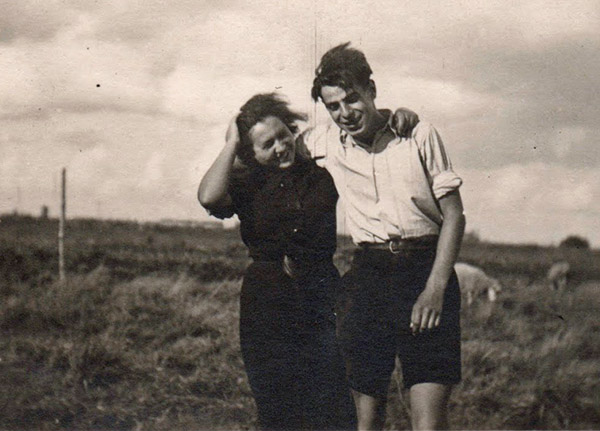
Friedel Peterseil and Ferdinand Ehrenberg
Photo: collection of Richard Hausmann, courtesy of Eric S. Hausmann.
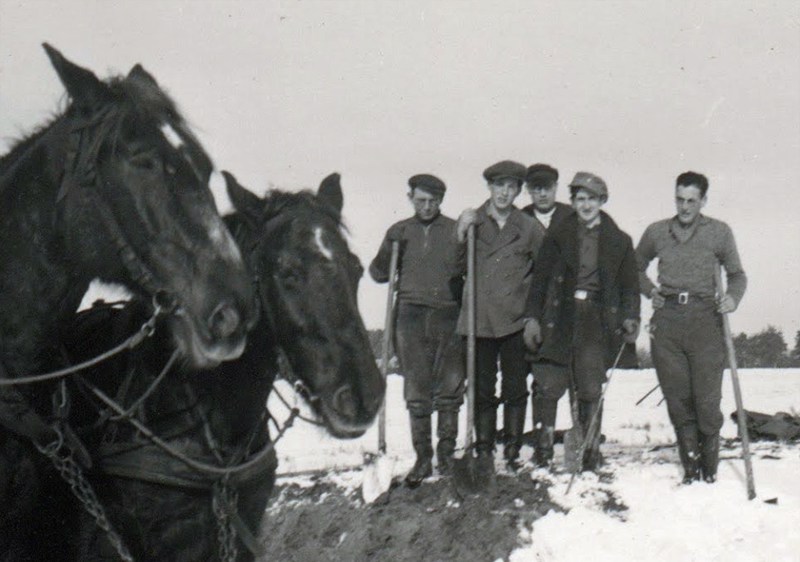
Collecting marl used to improve the quality of the soil. March 1937.
From left to right: Josef Lustig, ?, Ludwig Lilie, ?, Richard Hausmann
Photo by: Ferdinand (Nante) Ehrenberg. Collection of Richard Hausmann, courtesy of Eric S. Hausmann.

Group by the Mückenteich, a small pond near Kibbutz Jägerslust, 1936. Josef Lustig, fourth from the right, and Erna Weinert, third from the right.
Photo: collection of the Lustig family.
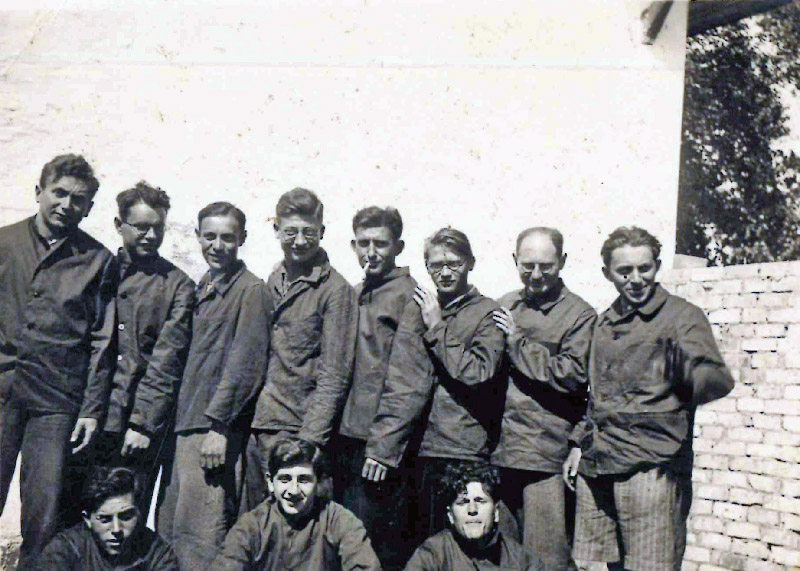
Group, 1936-1937. Josef Lustig is standing, second from the right.
Photo: collection of the Lustig family.
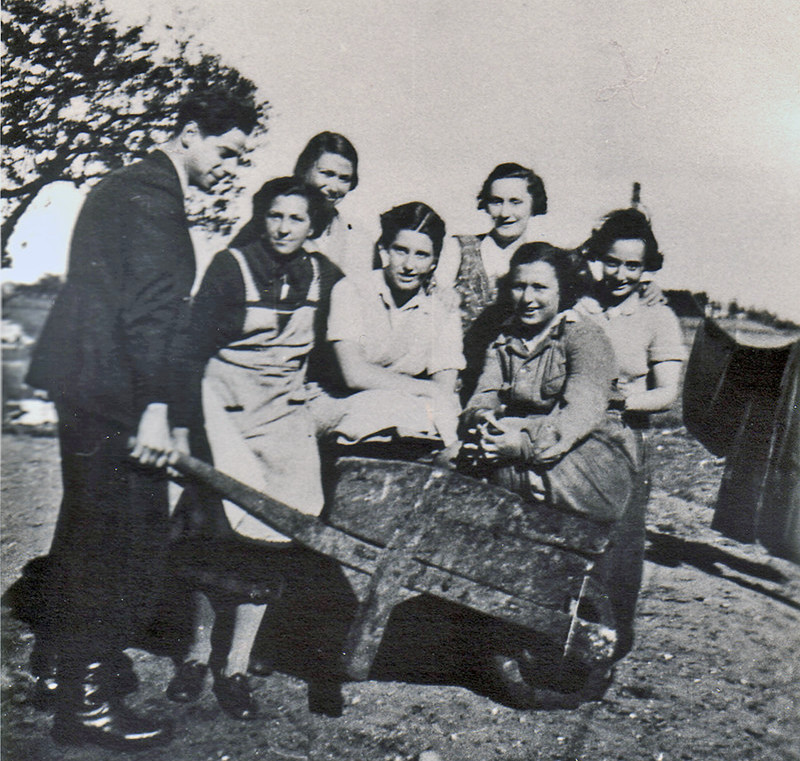
Sam Federmann with six women in Jägerslust, Flensburg, 1938. To the right is Sophie Charlotte Wald.
Note: Toni Katz *might* be first left in the back row
Photo courtesy of Bernd Philipsen.

Sam Federmann on top of the human pyramid. Jägerslust, Flensburg, 1938.
Photo courtesy of Bernd Philipsen.

Right: Sam Federmann
Photo courtesy of Bernd Philipsen.

Peeling potatoes.
Photo courtesy of Bernd Philipsen.
While the young men received agricultural training, the young women were mainly relegated to housekeeping tasks, cooking and washing. Lilli and Anne described their activities:
"My main activity was in the kitchen. So please: Imagine me as a kitchen fairy wielding a wooden spoon, with mottos and exclamations always ready: 'If you want to stand your feet up, then please don't be in the kitchen!' or: 'Look at the oven!' Because I never had a good fire. I tell you, that was a plague; the big pots. For 20-25 people! I could never get a taste (?) for it at first, and then it usually became a wish (?), when they got it, they wished for something else! Once we had boiled potatoes, a boy hadn't washed the potatoes clean, it was crunchy. [...] Then the bread wasn't there on time[...] I was so meschugge that I drove everyone out of the kitchen with my fuss and shouting [...]"
"Then I was in the laundry for a short time, a lot of work, but we enjoyed all the work. There was a wash every 14 days for 2 1/2 days and before the next wash everything had to be ironed, darned and patched. There were always 2 girls doing the housework for 2 months, cleaning the vegetables - [Frau Wollf] did the cooking herself, [two girls had to assist her] looking after the chickens, stealing the eggs and doing everything there was to do."
[Around the end of August or the beginning of September 1938] she "finally got on the field for the remaining 1 1/2 months. Potato, beet and corn crop. I learned threshing, milking, loading manure, leading horses, carrying 130 pounds."

Max Woislawski, Hans Rosenfeld and Siegbert Pinkus working in the fields. 1938.
Photo courtesy of Bernd Philipsen.
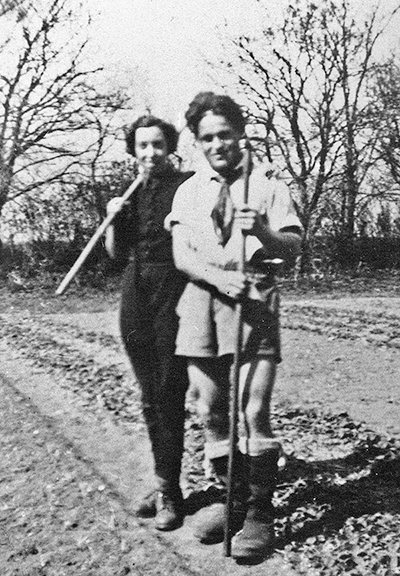
In the vegetable garden, Jägerslust.
Photo courtesy of Bernd Philipsen.

Milking cow
Photo courtesy of Bernd Philipsen.

Max Woislawski loading manure to be used as fertilizer. September 1938.
Photo courtesy of Bernd Philipsen.
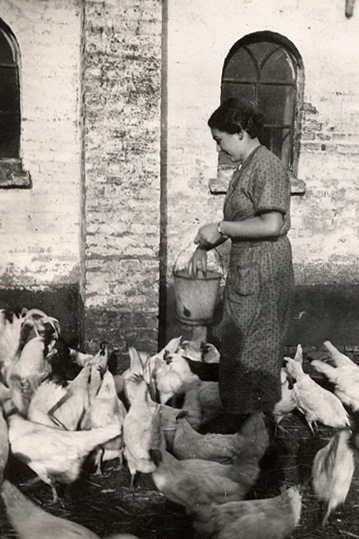
Toni Katz in "Kibbutz Jägerslust", Flensburg, August-November 1938.
Photo: collection Katz, courtesy of Shulik Mir.
The Wolff family and other key figures
| Name | Notes |
|
Alexander Wolff
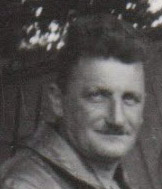
|
Alexander Ludwig Wolff was born March 28, 1891 in Berlin, the son of Georg Nathan Wolff and Katharine "Käthe" Wolff. His father Georg was a successful businessman who owned a textile factory in the Berlin area. Suffering from serious health issues, he was advised by his doctor to move to the countryside if "he wanted to live a few more years". Georg Wolff resigned from his professional functions, bought the Jägerslust estate on the outskirts of Flensburg, and moved there with his family in 1906. Alexander Wolff had planned to become an engineer and had started studying engineering. He interrupted his studies at the beginning of the First World War to volunteer for Germany and the Kaiser. His military service as a member of the machine gun squadron lasted until October 13, 1917 when he learned of his father's sudden death. As a result of the death of his father, Alexander changed his plans, gave up to his studies and took over his father's position running the farm. Alexander's family were secularized Jews who drifted further away from Judaism once they came to Jägerslust. His two sisters, Lilly and Susanne, converted in 1912 in order to be able to pursue their careers as teachers, and his father had told him that he could be baptized "like his sisters were." In February 1937, Alexander Wolff married Irma Altmann. She was a widoow, previously married to a dentist, Adolf Schüler. She doesn't seem to have participatd in running the daily activities with the students. Alexander Wollf was closely involved in the development of this trainees and provided theoterical instruction on modern fertilizer trechniques, while also providing hands-on practical training in the fields. Other topics that were out of the realm of Alex Wolff's expertise, such as modern Hebrew, Jewish traditions, and kibbutz life, were handled by visiting madrichim. . Lotte Wald recalled in her memoirs what she later heard had happened to the Alexander Wolff during Kristallnacht:
Alexander Wolff died in June 1984 (93) in Bergen County, New Jersey. His wife, Irma Wolff (Altmann) was murdered in February 1943 (51) in Auschwitz. |
|
Käthe Wolff
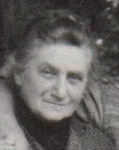
|
Käthe Wolff, née Jacoby, helped her son Alexander run the Hachsharah. On the night of the November Pogrom, she was arrested and taken to the Flensburg police prison along with her daugter-in-law Irma Wolff and the Hachshara students. She was released the next morning and found temporary accommodation in Flensburg, later moving to Berlin in early 1939. She was deported to Theresienstadt on August 14, 1942, from there on September 26, 1942 to Treblinka where she was murdered. Source: www.stolpersteine-berlin.de |
|
Yitzhak Shkedi

Collection of Richard Hausmann, courtesy of Eric S. Hausmann.
|
Yitzhak Shkedi was born October 10, 1912, to the Mandelbaum family in the town of Smiatycz, Poland. He studied Talmud Torah but also belonged to Zionist youth organizations. He immigrated to Eretz Israel in October 1930 at the age of 18. There he joined Kibbutz Givat Hashlosha where he worked in the orchard. He soon went to study at the University of Jerusalem. The Youth and Pioneer Department of the Agency later contacted Shkedi to go on a rescue mission in Nazi Germany. In 1935 he went to Germany where he coordinated and instructed in the training farms established by Hechalutz. Two groups of his trainees were allowed to immigrate to Israel, one to Ein Harod, while the second group arrived in Givat Hashlosha before the outbreak of World War II, in 1939. Because this photo was in Richard Hausmann's album, we can assume that Yitzhak Shkedi came to Jägerslust to provide instruction and guidance in topics out of the realm of Alex Wolff's expertise, such as modern Hebrew, Jewish traditions, and kibbutz life. Yitzhak Shkedi died in December 1982 in Kibbutz Einat. Source: Kibbutz Einat memorial |
|
Yehuda Marcus

|
Yehuda Marcus was born on February 29, 1912 in Hamburg, Germany. He was a member of the youth movements "Habonim" and "Halutz". After after graduating from high school, he turned to medical studies and intended to immigrate to Eretz Israel and become a doctor in a kibbutz. However, after five years of studies, although he excelled in them, he was failed due to his being a Jew. For the same reason, he was not allowed to complete training as a mechanics. Yehuda successfully passed a judo course and imparted his knowledge among Jewish youth. As a member of the "HeChalutz" leadership, he brought to Israel in 1936 a group of the Youth Aliyah. He then returned to Germany and, as a madrich (instructor) in the "Habonim" movement, moved from one Hachshara to another. Richard Hausmann recalled: "Yehuda Marcus was a member of the "Merkas Hechalutz" in Berlin, and was called [to Jägerslust] whenever insoluble problems arose, often with Alexander Wolff." In 1938 he immigrated to Israel with the last of the "Habonim" instructors, went through a training period at Kibbutz Givat Chaim - together with his friends who later founded Kibbutz Galed - and then enlisted in the Notrim, a Jewish auxiliary police force of the British Mandatory authorities. He later volunteered for the "German section" of the Palmach; when part of the department was recruited for the "Jewish Brigade" however Yehuda was disqualified for health reasons. He continued to be an instructor in dozens of courses, including courses for Gadna ("youth battalions"), a military preparation program. In one of these courses, he was hit by a stray bullet and died on June 22 1945. He was 33 years old and left a wife and a two-week-old baby. Source: |
Statistics
Between the fall of 1934 and the abrupt end on November 10, 1938, approximately 100 young people participated in the Hachshara (training) program in the Jägerslust estate of the Wolff family in Flensburg.
Based on a report by the Gestapo dated August 1935, the Jägerslust Hachshara could accommodate 25 people. At the time of the report it operated at half its capacity, with 12 people - 5 women and 7 men. By the end of its operation in November 1938, it operated at full capacity. According to Anne and Lilli Dreyfuss, there were 15 young men and 10 young women.
So far, 82 are known by name. (In some case only a first name is known.) The list below is thus incomplete and mostly covers the 1936-1937 period.
Of these 82 people,
Demographics:
- 54 were men (66%)
- 28 women (34%)
- 26 belonged to one of 13 couples (32%). Note that some of the couples were formalized after leaving the Hachshara.
- 4 belonged to 2 pairs of siblings
Fates:
- 58 survived the war (70%)
- 4 died in the Holocaust (6%)
- 1 died pneumonia in 1938 (1%)
- 19 fate unknown (23%)
Out of the 63 people whose fate is known,
- 58 survived the war (92%)
- 4 died in the Holocaust (6%)
- 1 died pneumonia in 1938 (2%)
Out of the 58 (?) who are known to have survived,
Destinations:
- 39 emigrated to Mandatory Palestine or Israel, either directly or later (67%)
- 5 emigrated to the USA - 1 in 1937, 2 in 1940, and 2 in 1950 (9%)
- 6 remained in Denmark or Sweden (10%)
- 3 remained in the Netherlands (5%)
- 2 emigrated to England (3%)
- 1 unknown destination
Of the 39 who emigrated to Eretz Israel,
- 28 (or 27?) came to Mandatory Palestine before the outbreak of the war
- 6 came in 1936 with a certificate (15%)
- 10 came in 1937 with a certificate (25%)
- 5 came in 1938 with a certificate (12%)
- 3 came in 1939 (1 legal, 2 as illegal aboard the Dora) (8%)
- 3 between 1936 and 1939 (no details) (8%)
- 3 came to Palestine during the war (8%):
- 1 in 1941
- 2 in 1944 via Portugal
- 4 came after the end of WW2 and before 1948:
- 2 came in 1945 (5%)
- 1 came in 1946 (3%)
- 1 came after the war, details missing (3%)
- 4 came to Israel after 1948:
- 2 came in 1949 after the War of Independence (5%)
- 2 came via Colombia in 1951 (5%)
3 later left Israel and emigrated to France (Toni Katz), England (Eva Lange) or the USA (Gertrud Leiter).
List of Hachshara trainees in Jägerslust
| Year | Name | City | Notes |
| 1936-1937 |
Felix Bender
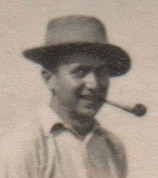
March 22, 1936. |
Photo: Richard Hausmann, courtesy of Eric S. Hausmann. No further information available. |
|
| June to Nov 9 1938 |
Albert Berger

ca 1942-43. |
Bonn |
Albert Berger was born May 3, 1919 in Siegburg, near Bonn, the son of Salomon Berger, a cattle dealer, and Elisabeth Berger. His father died in 1930 when Albert was eleven years old. Albert Berger came to Kibbutz Jägerslust as an "agricultural intern" on June 7, 1938, as recorded in the Flensburg city registration files. His brother Hermann Leopold (Chaim) Berger had preceded him there, having successfully completed his hachschara in Jägerslust, and having already emigrated to Palestine. Albert Berger's stay in kibbutz Jägerslust was brief. It ended abruptly on the night of November 10, in the early hours of the morning around three o'clock when the manor and the kibbutz were attacked by Nazi thugs under the direction of the Flensburg Police President and SS-Standartenführer Hinrich Möller. Albert Berger was taken to the Kiel police prison along with ten interns from Flensburg. He was then sent to the Sachsenhausen concentration camp, where he remained until December 28, 1938. After his release, he came to the Netherlands on January 12, 1939 and joined a hachshara group in Deventer, in the province of Overijssel. His hopes of completing his training and leaving the country were dashed by the occupation of the Netherlands by the German troops in May 1940. On October 3, 1942, Albert Berger was interned in Westerbork, the central transit camp for deportations to Eastern Europe. A year later, on September 14, 1943, a transport with 902 women, men and children, including Albert Berger, left Westerbork for Auschwitz. The train took two days to reach the German death factory in Poland. Berger was used for forced labor in the Monowitz concentration camp (Auschwitz III). Albert Berger died in Auschwitz-Monowitz on February 19, 1944. He was 24. According to the testimony of Shlomo Samson, Albert Berger's photograph was taken in the Westerbork camp by Werner Rudolf Breslauer, apparently with the intention of its future use by members of the Zionist pioneering underground (in the camp and outside it) for producing forged identity documents for the purpose of escaping from the camp. Albert's mother, Elisabeth Berger, was deported from Cologne to the Minsk Ghetto on July 20, 1942. His brothers Adolf (Adi) and Hermann (Chaim), emigrated to Israel. Sources: |
| 1936-1937 |
Hermann Berger
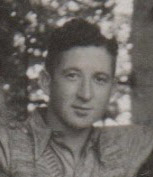
|
Duisburg |
Hermann Leopold Berger was born January 5, 1918 in Niederzissen, the son of Salomon Berger, a cattle dealer, and Elisabeth Berger. He had two brothers, Adolf (Adi) and Albert. His father died in 1930 when Hermann was twelve years old. Hermann Berger came to the Gut Jägerslust Hachshara in 1936-1937 to prepare for his emigration to Palestine. His brother Albert Berger would follow in his footsteps and join the Hachshara in after Hermann's departure. Hermann Berger arrived in Palestine on February 28, 1938. At the time of his 1940 application for naturalization, he lived in Kvutzat Massad near Ein Harod and was an agricultural laborer. (The address was crossed out and replaced with "Atlit". It's not clear if this means he had relocated to Atlit, or was incarcerated in the Atlit detainee camp.) Other Jägerslust alumni who settled in Kvutzat Massad included David (Adi) Sporn, Eva Lange and Gunther Riesenfeld. He was finally granted citizenship in September 1942. He later married Anne Oppenheimer and the couple had two children. He changed his name to Chaim Berger. Chaim (Hermann) Berger died in February 1962 (44) in Haifa. Hermann's mother, Elisabeth Berger, was deported from Cologne to the Minsk Ghetto on July 20, 1942. His brother, Albert Berger, was deported from Westerbork to Auschwitz-Monowitz in September 1943, where he died on February 19, 1944. Hermann's brother Adolf (Adi) also emigrated to Israel. |
| May 1937 - Feb 1938 |
Werner Brock
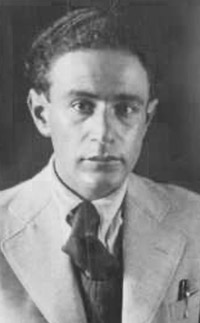
1940
|
Düsseldorf |
Werner (later Uri) Brock was born May 11, 1919 in Düsseldorf, the son of Israel Isidor Brock and Alma Brock (nee Herz). He had one brother, Walter (later Haim). His father died in 1930 and his mother in 1932. Werner became an orphan around the age of 13, and relatives took care of him and his brother. According to the registration card of the city of Flensburg, Werner Brock was in Flensburg from May 4, 1937 to February 2, 1938. (He later declared in an affidavit that he joined Jägerslust "at the end of 1936".) In 1975, he filled out the following affidavit regarding his stay in Jägerslust:
Werner received an immigration visa and arrived in Palestine on February 28, 1938. At the time of his application for British Mandatory Palestinian citizenship in 1940, he lived in Jerusalem and was unmarried. His profession was listed as "policeman" on one document, and as "temporary additional watcher" ("shomer": שומר זמני). He married Gisela (Golda) Lustig, the younger sister of Josef Lustig, another trainee in Jägerslust whom he had met in Palestine, and the couple had two children. Werner changed his name to Uri Brock. Uri (Werner) Brock died in December 1982 (63) in Holon. His brother Walter (Haim) emigrated to Palestine in 1935 and lived in Kibbutz Beit Hashita. He was shot to death by Arabs while on his horse on the fields of the Kibbutz in 1937. Werner joined the British police with the mission to find those who had murdered his brother. Sources: |
| 1936-1937 |
Gerhard Cheim

|
Breslau (Wrocław) |
Gerhard Cheim was born on January 31, 1912 in Wreschen, in Prussia (now Września, Poland), the son of Max (Mose) Cheim and (unknown) Cheim. The family presumably left Wreschen after it became part of Poland in 1920 and came to Breslau. Gerhard Cheim came to the Hachshara in Gut Jägerslust around 1936-1937. It is not known if he came to with his future wife, Dora Herbst, or met her there. Gerhard Cheim married Dora Herbst in April 1938 in Cologne. According to his passport, Gerhard was at the time a farm hand (landwirtschaftsgehilfe) and the couple resided in Cologne until September 19, 1938. Their first son was born in July that year in Cologne. At the begining of 1939 they received a one-year visa for Colombia and fled from Germany with their baby son. With nowhere else to go, they remained in Colombia illegaly after the expiration of their visa. There they lived in Barranquilla under difficult financial circumstance. Gerhard sold coffee in the marketplace and Dora had a small grocery store she ran from their home. Their second son was born in Colombia. The family finally emigrated to Israel in February 1951. Gerhard Cheim died in October 1971. Gerhard's father, Max Cheim was deported from Breslau on April 13, 1942 to the Izbica Ghetto where he was murdered, presumably during the liquidation of the ghetto on November 2, 1942. Based on the 1939 German Minority Census, Gerhard *may have had three siblings who lived with his father at the time of the census: Leo Cheim (1906), Hugo (1907) and Martin (ca 1923). The fate of his mother is not known. As she is not listed in the German Minority Census of May 1939, it is assumed that she had died before the war. Sources: |
| Apr 1938 to ? |
Helena Croner

|
Hamburg |
Helena (Helene, Lenie) Sara Croner was born January 3, 1919 in Hamburg, the daughter of Walter Croner and Jenny Meyer. She had five siblings: Anna, Leopold, Meta, Ruth and Herbert, and a half-brother, Hermann. Helena came from a poor family. Her father, Walter Croner, a waiter, was called up for military service on June 23, 1915. On the following day, his wife Jenny applied for welfare support, as she was "completely penniless" and had been left with four children. Her father suffered from the effects of a mustard gas attack, and never had a stable job again. In 1928 he lost his job and would remain unemployed until his death. From the beginning of the 1930s the family was almost constantly on social welfare and lived in poverty. Helena's father died in 1934 when she was fifteen years old. In May 1934 Helene began to study and lived for a period in Berlin. At the end of 1934 she returned from Berlin to her family home. A few days after being in Hamburg she worked as a domestic servant. In April 1938 Helena left Hamburg and joined the Hachashara in Gut Jägerslust. It is not known how long she remained in Flensburg. Less than a year later, in March 1939, she emigrated to the Netherlands. There she continued to undergo the preparation for emigration with the Deventer Association. She first stayed in Weerselo from April 1939 to the end of December 1939. She then spent a few days in Deventer with Ru Cohen, the founder of the Deventer Association. She later left for Brummen. Following the German invasion in May 1940, she was not able to emigrate and remained in the Netherlands. In 1942, she married Michiel Asser Benjamin Jacob and the couple moved to Zelhem, where they took over the shop in smoking articles from his parents. Her husband was later deported and perished in the Holocaust. Helene survived the war. She later married Johannes Hendrikus (Han) Roenhorst and remained in Zelhem. Helene Roenhorst (Croner) died in April 1999 (80) in Zelhem, Netherlands. Her mother, Jenny Croner, and her sister, Ruth Croner, were deported to the Litzmannstadt (Lodz) Ghetto on October 25, 1941. Jenny Croner was then transported to the Chelmno death camp on May 10, 1942 where she was murdered. Ruth Croner suffered a similar fate on June 14, 1942 on her 31st birthday. Her sister, Anna Croner (27), a domestic servant, later a worker in a fish factory, was arrested for having had two self-administered illegal abortions and under he suspicion of having commited "racial defilement" (Rassenschande). She was sentenced to 6 weeks imprisonment for the abortions, which the court regarded as a "lenient sentence". Anna was later imprisoned in the Fuhlsbüttel Concentration Camp, then transferred on May 29, 1941 to the Ravensbrück Concentration Camp where she died on March 20, 1942. Her brother, Leopold Croner (26), was imprisoned in the Fuhlsbüttel Concentration Camp in August 1941, then transferred on October 3, 1941 to the Neuengamme Concentration Camp where he died in June 1942. Her sister, Meta Croner (21), was incarcerated in the Fuhlsbüttel Concentration Camp, then transported to Ravensbrück where she died on October 20, 1942. Her first husband, Michiel Asser Benjamin Jacob, was deported to the Gross-Rosen concentration camp where he died in February 1945, one week before the liberation of the camp by the Red Army. Her brother, Herbert Croner, was incarcerated in the Fuhlsbüttel Concentration Camp from 1938 until 1939 for being an unemployed Jew, then from 1939 to 1942 in penitentiaries in Celle and Hameln. He was then deported to Auschwitz and finally Dachau. He survived until the liberation of the camp and was able to emigrate to the USA in 1946. (Some details about Herbert Croner's life seems fantastical and he seems to have been creative with his biography; His incarceration in Dachau at the very least is documented.) Her half-brother Herman, who, because of his non-Jewish father was classified as a "Mischling of the first degree", was not as severely effected by the persecution as his mother and sisters and survived the war. Sources: |
| 1936-1937 |
Erika Dallmann

|
Rügenwalde |
Erika Dallmann was born October 16, 1907 in Rügenwalde. After her stay in Jägerslust, she went to Denmark for further training in the framework of the exchange program. In November 1940 she was registered as living in Kongsted, Zealand, Denmark. At the same location resided Regina Woislawski and Frieda Landmann. Erika Dallmann married Heinz Beer, and the couple had two children. Erika Beer (Dallmann) died in June 1982 in Fredensborg, Denmark. Sources: |
| Feb 38? to Nov 9 1938 |
Anne Rose Dreifuss
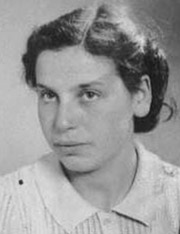
|
Anne Rose Dreifuss was born on October 17, 1918 in Sulzbach, Saarland, Germany, the daughter of Emil Dreifuss, from Sulzbach, and Toni Löwenbach, from Freienohl, a small town 100kms from Bochum. She had two siblings, Lilli Marie Dreifuss, another Jägerslust trainee, and Walter Otto Dreifuss. The Dreifuss family moved to Bochum in 1924. Anne's father was a salesman, and her mother had a small arts and crafts shop. The Dreifuss family acquired a three-floor building 28 Rheinische Strasse in Bochum where they lived, together with their two widowed mothers-in-law. Details about the Dreifuss family are found in Ihr Seid Nicht Vergessen (A Chronicle of Memory of the Dreyfus Family, by Kay Dreyfus):
Anne and her sister Lilli joined the Gymnastics group of the RjF in Bochum around 1934-36. (The Sportbund Schild des Reichsbundes jüdischer Frontsoldaten ("Sports Association Shield of the Reich Federation of Jewish Frontline Soldiers") was a Jewish sports organization associated with the Reich Federation of Jewish Frontline Soldiers. The RjF was formed in 1919 as a patriotic association of Jewish war veterans to demonstrate Jewish loyalty to Germany. After the rise of the Nazis, Jews were driven from mainstream sports clubs. As a result, the association saw a rise in membership after 1933, until its activities were outlawed by the Nazi regime in 1936.) Because it seems to have been the only Jewish sports association in Bochum, their membership doesn't necessarily mean that their father was a German nationalist or a veteran of WW1. Anne Dreifus came to the Gut Jägerlust Hachshara on February 10, 1938. Her sister Lilli would join her later in July. In May 22, Anne and another girl were sent to another Hachshara in Hamburg, where she spent four months. There she did housekeeping chores - laundry, ironing, cooking. She wrote:
She then returned to Flensburg, where she was reassigned to the laundry to darn and iron. She finally got on the field for the remaining 1 1/2 months of her stay:
Anne and Lilli remained in the Hachshara, presumably until the abrupt end on November 9/10. According to her friend Lotte Wald's memoir however, she had visited Anna Dreyfus in Hamburg in October. She recalled that Anna "took care of chaverim who worked on ships in Hamburg and lived in the so-called 'seamen's club' (presumably Lucy Borchardt's shipping company who had set up a 'maritime Hachshara'). She later stated that she met Anna the day after Kristallnacht in Hamburg by chance, implying that Anna had not been in Jägerslust during the events of the November Pogrom as assumed, but had been in Hamburg. She wrote:
Anne and her sister Lili were back home with their parents in Bochum on November 11, 1938. On January 24, 1939, Anna's father wrote to the foreign exchange office in Münster concerning goods his daughters wished to take with them to Holland, from where they planned to emigrate to Palestine. Most of the things they wanted to take - work clothing and bicycles - had been given to them by acquaintances and charitable institutions.
On February 5, 1939, the sisters wrote a long letter to a friend who had emigrated to the USA, in which they described in detail their experience in the hachshara. They were waiting for the exit permit, and expected to leave on February 15, 1939 for the Netherlands where they planned to continue their Hachshara. However, their departure was delayed and they were still waiting to be called on March 3, 1939. They finally received the permission to leave later that month and Anne, aged twenty, and Lilli, eighteen, came to the Netherlands before the end of March 1939. Anne and Lilli's plans to emigrate to Palestine were not to be, and they would remain trapped in the Netherlands after the German invasion in May 1940. Anne lived in Amsterdam where she worked as a housemaid. On September 3, 1942 she was taken to the Westerbork camp. She was then deported the following day to Auschwitz-Birkenau. Of the 714 men, women and children in that transport, 661 were sent to the gas chambers on arrival. Anna was among the victims, murdered on September 7, 1942. She was 24 years old. Anne's father, Emil Dreifuss, was arrested in the November pogrom on November 10, 1938 and was incarcerated in Sachsenhausen until mid-December. Her parents tried to leave Germany after Kristallnacht, but their efforts were in vain. They finally sold the family house in 1940 which was then turned into a "Judenhaus", where they continued to reside until their deportation. After paying off their mortgage, debts and taxes, the remaining balance from the sale was placed in a blocked account from which they only received a minimal monthly subsistence allowance. Anne's mother, Toni Dreifuss, was deported on April 30, 1942 from Dortmund to the Zamosc Ghetto, where she arrived on May 3, 1942. She was then presumably murdered in Belzec. It is assumed that Emil Dreifuss shared the same fate. His name however doesn't appear on the list of deportees to Zamosc; it is thus possible that he perished before the deportation. Lilli Dreifuss, Anne's sister, came to the Netherlands where she married Salomon Bernard de Leeuw. Lilli and her husband were taken to Westerbork on April 22, 1943. From there they were transported to Sobibor, where they were murdered on April 30, 1943. Anne's brother Walter came to the Netherlands at the age of twelve on a Kindertransport in January 1939. He was first placed in a children's home in Bergen aan Zee, then later joined a Youth Aliyah program "het Paviljoen" in Loosdrecht. Following the start of the deportations in August 1942, Walter most likely went into hiding with other members of the Loosdrecht group. He later managed to escape from the Netherlands, crossing into Belgium, France, then across the Pyrenees, finally reaching Spain in March 1944. (It's assumed that his escape was organized by the Westerweel resistance group which helped an estimated 300-400 Jews flee from the Netherlands to Spain in 1943-1944). Walter arrived in Haifa on November 5, 1944. (Aboard that ship was Siegfried Rosenthal, a Jägerslust trainee who had followed a similar escape route from the Netherlands to the Pyrenees and Spain.) Walter Dreifuss tragically died during a night manoeuvre as an Israeli soldier from a snake bite in 1950. Sources: Further Reading: |
|
| July 1938 to Nov 9 1938 |
Lilli Marie Dreifuss
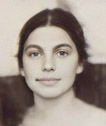
ca. 1936 (Gymnastic group of the RjF)
|
Lilli Marie Dreifuss was born March 28, 1920 in Sulzbach, Saarland, Germany, the daughter of Emil Dreifuss, from Sulzbach, and Toni Löwenbach. She had two siblings, Anne Dreifuss, another Jägerslust trainee, and Walter Otto Dreifuss. The Dreifuss family moved to Bochum in 1924. Lilli's father was a salesman, and her mother had a small arts and crafts shop. Lilli and her sister Anne appear on a photo of the Gymnastics group of the RjF in Bochum around 1935-1936. (Because it may have been the only Jewish sports association in Bochum, their membership doesn't necessarily mean that their father was a German nationalist or a veteran of WW1.) Lilli came to the Gut Jägerlust Hachshara on July 9, 1938. There she joined he sister Anne Dreifuss who had arrived five months earlier in February. It is assumed that Lilli remained there until the abrupt end on November 9/10. If Lilli and her sister were indeed in Jägerslust during Kristallnacht, they were arrested during the November Pogrom and taken to the Flensburg jail where they would have spent the night, along with the other Jägerslust trainees. They would then have been released the following morning, together with all the young women. Lilli and her sister were back home with their parents in Bochum on November 11, 1938. There is however no mention of Lili Dreyfus in Lotte Wald's description of the November 9/10 events. Also, neither Lili nor Anna mentioned anything regarding the destruction of Jägerslust in their letter to their friend in America. It is thus possible that Lili had already left the Hachshara prior to the November Pogrom and did not witness its end. Lilli and Anne were permitted to leave Germany in February. Lilli was allowed to bring secondhand work clothes and her old bicyle, their total value estimated to 16.95 RM. They were in the Netherlands by March 1939. Lilli lived in Arnhem where she was a caretaker for the elderly. She married Salomon Bernard de Leeuw, a native from Arnhem. The couple appears to have gone into hiding, sometime between the begining of the deportations in August 1942 and January 1943, as indicated by a notice in the January 28, 1943 issue of the Algemeen Politieblad. The Arnhem police commissioner requested that Salomon Bernard de Leeuw be located, detained and brought to trial for having changed his place of residence without the required authorization. This description referred to Jews who had gone into hiding. Lilli was taken into police custody in April 1943 in Schevenigen, 75 miles (120km) from Arnhem. A week later, on April 22, 1943, Lilli and her husband were taken to the Westerbork camp. From there they were deported to Sobibór in a transport of 1204 Jewish men, women and children, where they were murdered on arrival on April 30, 1943. She was 23 years old. Lilli's mother, Toni Dreifuss, was deported from Dortmund to the Zamosc Ghetto on April 30, 1942. She was then presumably murdered in Belzec. It is assumed that her father, Emil Dreifuss, shared the same fate. Her sister Anne was deported from Westerbork to Auschwitz on September 4, 1942, where she was murdered on September 7, 1942. Her brother Walter came to the Netherlands at the age of twelve on a Kindertransport in January 1939. He managed to escape from the Netherlands, and reached Spain in March 1944. He then went to Portugal from where he boarded a ship that brought him to Haifa on November 5, 1944. Sources: Further Reading: |
|
| 1936-1937 |
Ferdinand Ehrenberg

|
Karlsruhe |
Ferdinand Ehrenberg was born December 8, 1917 in Karlsruhe. After Jägerslust, Ferdinand Ehrenberg went to Denmark for further training in the framework of the exchange program. According to the 1940 Denmark Census, he was registered in Høje Tåstrup as of November 5, 1940, where he attended the Slangerup Agricultural School. He was in the school with Bernhard Lieser at least until spring of 1941 as evidence by this testimony ("Unge jøders flugt 1939-1945"):
Ferdinand Ehrenberg married Else Bodil Anni Jönsson from Kopenhagen. The couple's last place of residence in Denmark was Roskilde. Aware of the upcoming planned deportation of Jews from Denmark, Ferdinand and his wife Else, who was not Jewish, fled to Sweden aboard a fishing boat in the night of October 8, 1943, arriving the next afternoon in Klagshamn near Malmö. According to the immigration form filled out upon his arrival in Malmö, Ferdinand Ehrenberg declared being penniless ("money brought: none"). The couple had one son born in 1950. Ferdinand Ehrenberg died in January 1994 in Gothenburg, Sweden. Sources: |
| Mar 1937 to Oct 1938 |
Sam Federmann

|
Chemnitz |
Samuel (Sam, Samo) Federmann was born in 1917 in Chemnitz, Saxony, the son of David Aharon Federmann, a bakery owner originally from Pinsk, and Tzipora Kupfermunz. Samuel had four siblings: Xaver (later: Yekutiel), Miriam, Susy, and Paul. Sam's father instilled Zionism in his children and Sam and his brother Yekutiel were active in Zionist organizations - Yekutiel with the Halutz and Dror groups, and Sam with the Zionist Youth Organization from 1927 to 1938. In 1933, with the rise of the Nazi party to power and the growing harassment of the Jews, the family decided to leave Germany and in 1936 they immigrated to Belgium, with the brothers Yekutiel and Shmuel staying behind to continue their activities in the Zionist organizations. From 1936 to 1938, Sam Federman followed training in preparation for emigration to Palestine, first in Hamburg, then at the Jägerslust estate in Flensburg, from February/March 1937 until the end of October 1938. He was away in Berlin for medical treatment and was not present during the attack on Jägerslust during the November Pogrom. Sam and his brother Yekutiel decided to leave Germany after Kristallnacht. His escape from Germany took him to Belgium (1938), France (1939, volunteer in the French Army) and Spain (1940), where he was interned for a long time in a camp. He finally reached Haifa on the SS Nyassa on February 4, 1944. (The SS Nyassa was the first ship since the outbreak of the war to arrive in Palestine with a group of legal immigrants from Europe. Onboard were 750 refugees, including my grandmother.) A hotelier and entrepreneur, Samuel founded the Dan Hotels Corporation in 1947 with his brother Yekutiel. In 1945, Samuel and his brother Yekutiel had purchased a pension in Tel Aviv, then in 1953 built the Dan Hotel on the spot. This hotel was the beginning of the establishment of the Dan hotel chain , which has 13 hotels throughout the country. In 1989, the Federmann brothers retired from managing the hotel chain and transferred the management to their respective sons. Shmuel (Samuel) was married to () Stecklmacher and the couple had two children. Sam Federmann died in January 2006 in Tel Aviv. Sam's parents and siblings all managed to emigrate and survived the war. His parents, his sister Martha (Miriam) Hecht, and his brother Yekutiel, emigrated to Palestine. Yekutiel left Germany in August 1939 and moved to England, then in 1940 to Palestine. His brother Paul (Szaja, Chaskiel) Federmann emigrated to Mexico in 1945. His sister Susi Gerstl (Federmann) emigrated to South America (Cuba or Mexico?). Sources: |
| 1936-1937 |
Herbert Feinstein
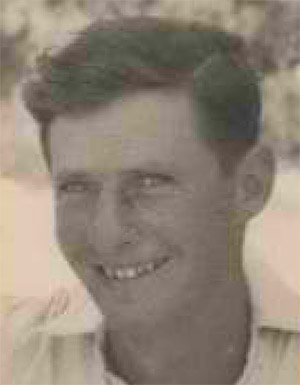
1944
|
Although this cannot be confirmed without more information, the following is most likely the biography of the Herbert Feinstein who attended Jägerslust. Herbert Feinstein was born March 24 1914 in Köln, the son of Helena and Max Feinstein. As a child he studied at the local school and from there went on to study at a religious gymnasium. Following his mother's illness he moved to his uncle's house in Stuttgart, where he attended a trade school. Upon graduation, he returned to Cologne to help support the family and joined the HeChalutz movement. Herbert Feinstein left Germany and came to Sweden. There, as mentioned in "Hachshara and Youth Aliyah in Sweden 1933-1948", he led a Youth Aliyah group from Helsingegården to Palestine on April 20, 1941. Herbert Feinstein and the group arrived in Palestine on May 7, 1941. In 1944, he married Ursula (later Rachel) Marcuse and applied for Mandatory Palestine citizenship in November 1944. At the time, he resided in Kibbutz Alonim and was an agricultural laborer. Herbert later assumed the name Chanan Feinstein. Chanan and Rachel (Ursula) Feinstein had four children. Chanan (Herbert) Feinstein died in September 1990 in Kibbutz Alonim. Sources: |
|
| ? to July 1936 |
Magdalena Felicitas Ferenszi

|
Hungary |
Magdalena Felicitas Ferenszi was born in Öcsöd, Hungary, January 16, 1916. *Note: Assuming she was a trainee in Jägerslust because her passport was issued in Flensburg on July 6, 1936 and she emigrated to Palestine two weeks later (July 22, 1936) with her husband Hans Oppenheimer, another Jägerslust trainee. The lived in Kibbutz Ashdot Yaakov. Source: www.archives.gov.il (Application for Palestinian Citizenship, 1939) |
| 1937 to Nov 9 1938 |
Eva Fink

|
Posen |
Eva Fink was born February 11, 1921 in Posen, Germany. She joined the Zionist youth organization Habonim in Breslau. She then started her hachshara in Jägerslust from 1937 to 1938. She continued her training in the Elgut hachshara the same year. Her training ended abruptly on November 9, 1938 during the so-called November Pogrom (Krisallnacht), when the Elgut house was stormed, the chaverim beaten and taken away. At the same time, her father was sent to a concentration camp and his business destroyed. Eva Fink fled Germany in March 1939, going from Breslau to The Hague with the help of the Hechalutz organization. From May 1940 to July 1942, she continued her agricultural training in De Steeg near Arnhem, with the Deventer Association and with local farmers. In May 1942 she joined the Jewish mental institution "Apeldoornsche Bosch" as a gardener. She was able to leave the facility on the eve of its evacuation, following which all patients and most employees were sent to their death in Auschwitz. From there she went into hiding, staying with five Christian families until the liberation of Holland on April 5, 1945. Eva Fink made Aliyah in August 1945. She was married in 1947 and had two children: Naomi, in 1949 and Michael, in 1952. She changed her name to Chava Lehmann (חוה להמן). Sources: |
| 1936 |
H. Finkelstein
|
A chalutz named H. Finkelstein appears on a photo next to Erna Weinert on the roof on of the "kibbutz" on March 22, 1936. No further information available. |
|
| ? to Nov 9 1938 |
Ernst Fischer

|
Frankenthal |
Ernst Jacob Fischer was born August 17, 1918 in Frankenthal, Bayern. Following the attack by local Nazis on Jägerslust in the night on November 10 ("Kristallnacht"), Ernst Fischer was taken to the Kiel prison as evidenced by the presence of his name in the "custody book". He was then incarcerated in the Sachsenhausen concentration camp, from where he was released on December 28, 1938. Ernst Fischer later came to the Netherlands (Almen: Het Laren). He then boarded the Dora, an illegal immigration ship in July 1939 and arrived in Palestine on August 12, 1939, two weeks before the start of the war. (Another Jägerlust member who escaped on the Dora was Toni Katz.) Sources: |
| Mar 1936 to May 1937 |
Willi Friedmann

|
Breslau (Wrocław) |
Willi Friedmann arrived in Jägerslust on March 1, 1936 from Breslau as an agricultural trainee. A year later, on March 3, 1937, he married Jenny Jaschkowitz, another Jägerslust trainee from Breslau. Jenny and Willy left Jägerslust in May 1937 and later emigrated to England. The couple had one child. Willi Friedman died in 1982 in London. Sources: |
| 1936-1937 |
Ruth Hamburger

|
Although unconfirmed, the following profile is likely match for the Ruth Hamburger who attended Gut Jägerslust, based on circumstancial evidence (date of birth, emigration, attending a hachshara) and a ressemblance between the hachshara photo and later pictures. Ruth Hamburger was born in Dolitz, a small town in Germany, on April 6 1910, the daughter of Adolf and Meli (?) Hamburger. She had two sisters, Eva and Edith. She came from a home where Reform traditions were kept. Her family's financial situation was good, until it deteriorated during the depression in Germany. During this period the family lived in Berlin. There, under the influence of her eldest sister, Eva, she got closer to Zionism. She went to agricultural training (Hachshara). As the date of immigration approached, and in order to save a certificate, Ruth entered into a fictitious marriage with a friend, Heinrich Freund (later: Chaim Yadid). Together they emigrated to Palestine in March 1937 and joined Kibbut Givat Haim. Upon joining the kibbutz, all the couple's belongings were transferred to the collective, and they experienced the early pioneer conditions - living in a tent at first, and then in a poor shack. This union turned out to be long-lasting and the couple had three children. She later adopted the name Ruth Yadid. Ruth Yadid (Hamburger) died in 2001 in Kibbutz Givat Haim at the age of 92.
Sources: |
|
| Oct 1936 to June 1937 |
Richard Hausmann

|
Düren |
Richard Hausmann was born August 12, 1914 in Düren, Rhineland. There, he first attended a Jewish elementary school, then a municipal secondary school (Realgymnasium) until the age of 17, finally going to a vocational school until the age of 18. He was employed in the department store of Leonhard Tietz in Düren, until the end of March 1934 when it was "Aryanized" and all Jewish employees were dismissed. He then started studying to become a textile engineer at the weaving school (Höhere TextilFachschule) in Aachen. Richard Hausmann came to the Jägerslust hachshara to follow agricultural training on October 19, 1936. There he met his future wife Erna (Ernestine) Weinert. Richard and Erna left Jägerslust at the end of June 1937, and temporarily moved with farmers in Rohr, Thuringia, where they remained until November 1937. Upon leaving the Hachshara, Alexander Wolff wrote a letter of recommendation:
Richard and Erna left Germany in February 1938 and came to Sweden, where they remained for 18 months. As their residence permits could not be renewed, they then left Sweden and came to Denmark in September 1939. There, they found work on farms in South Zealand together with other Jews. For a short time, Richard worked on Harald Petersen's farm, while Erna was hired on a neighboring farm. They then both found work in Haslev, where their son Herman was born. In 1941, Harald and his wife Agnete moved to a farm in Ostbakkegaard near Copenhagen, and in 1942 the Hausmann couple were hired on Harald Petersen's farm, with Richard working as a herdsman. On Sunday, September 30, 1943, Harald Petersen learned of the Germans' plan to deport all Jews of Denmark to concentration camps, so the next morning he drove the Hausman family to Copenhagen, where they went underground and remained in hiding with friends in Bronshoj, in the suburbs of the city. After three days without finding a fisherman to take them across the waters, Harald Petersen finally found a fisherman to take them and paid 3,000 crowns for their escape with his own money. During the night between October 3 and 4, 1943, the Hausmann family, together with a group of Jews, were transported to Sweden by fishing boat. (On March 28, 1990, Yad Vashem recognized Harald Petersen as Righteous Among the Nations for having risked his life to arrange the Hausmanns' escape.) Richard and Erna emigrated to the USA in August 1950 and lived in Longmeadow, Massachusetts. Richard Hausmann was an engineer in the fabric industry. The couple had three children: Hermann, (Copenhagen, 1942), Ruth, (Sweden, 1944), and Stephen David (USA, 1950). Richard Hausmann died in December 2007 at the age of 93 in Longmeadow, USA. Sources: |
| 1936-1937 |
Dora Herbst

|
Köln |
Dora Mina Herbst (later Cheim) was born November 28, 1913 in Antwerp, Belgium, the daughter of Yitzhak Herbst. She had one sister, Sarah. Sarah was born in Tuchow, Austria-Hungary (now Poland), in 1909, suggesting that the family originally came from Galicia, and placing the time of their emigration to Belgium between 1909 and 1913. The family may have then moved to Cologne as both Sarah and Dora lived in Cologne in the 1930s. Dora Herbst came to the Hachshara in Gut Jägerslust around 1936-1937. It is not known whether she came with her future husband, Gerhard Cheim, or met him there. Dora and Gerhard were married in April 1938 in Cologne, and their first son was born a few months later in July. The couple resided in Cologne until September 19, 1938. At the begining of 1939, they received a one-year visa for Colombia and fled from Germany with their baby son. With nowhere else to go, they remained in Colombia illegaly after the expiration of their visa. There they lived in Barranquilla under difficult financial circumstance. Dora had a small grocery store she ran from their home, and her husband Gerhard sold coffee in the marketplace. Their second son was born in Colombia. The family finally emigrated to Israel in February 1951. Dora Cheim (Herbst) died in Israel in February 1953. Her sister, Sarah Tzukerman (presumably) emigrated to Israel and survived the war. The fate of her parents is not known. Sources: |
| 1936-1937 |
Herbert Hirsch

|
Münsterberg |
Herbert (Zvi) Hirsch was born December 3, 1914 in Münsterberg, Germany (today Ziębice, Poland), the son of Max and Margaret Hirsch. Following his stay in Jägerslust, he came to Copenhagen. He then immigrated to the USA in August 1937 and first lived in Pittsburgh, PA. His 1940 draft registration card indicates that, by then, his father Max lived in Detroit, Michigan, suggesting that the family either had relatives in the USA, or sufficient means to secure American visas for the entire family. Herbert Hirsch later changed his name to William Mar Anderson. He died in October 1969. Sources: |
| 1936-1937 |
Lotte Honig

|
No further information available. |
|
| Aug 1936 to Mar 1937 |
Bernhard ("Männe") Horn
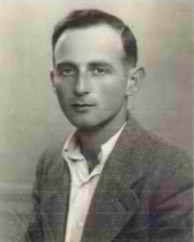
1941
|
Köln |
Bernhard ("Männe") Horn was born June 16, 1909 in Cologne. He married Margot Horn (born Lange), another trainee in Jägerslust. Bernard and Margot arrived in Palestine April 19, 1937. They first lived in Haifa. His profession was listed as "laborer". The couple had (at least) one child, a daughter, Noah, born January 1938 in Hadera, Israel. Source: www.archives.gov.il |
| Aug 1936 to Mar 1937 |
Margot Horn

1941
|
Berlin |
Margot Horn (nee Lange) was born January 11, 1911 in Berlin, the daughter of Ludwig Lange and Helena Wolf. She had two brothers, Gideon and Herbert. Margot was married to Bernhard ("Männe") Horn. Margot and Bernhard came to Palestine April 19, 1937. The couple had one daughter, Noah, born January 1938 in Hadera. Margot Horn died in July 2005 in Haifa. Margot's brothers emigrated to Israel. Sources: |
| 1936-1937 |
Ernst Isaksohn (Isackson)

|
No further information available. |
|
| Mar 1936 to May 1937 |
Jenny Jaschkowitz

|
Breslau (Wrocław) |
Jenny Jaschkowitz (later: Jenny Friedman) was born March 23, 1914 in Posen, Prussia (later: Poznań, Poland), the daughter of Julius Jaschkowitz, a merchant, and Freda Jaschkowitz (nee Blut). Both her parents were originally from Poznan. The family came to Breslau, most likely shortly after the end of WW1 when Poznan became part of Poland. Jenny Jaschkowitz came to the Jägerslust Hachshara from Breslau on March 23, 1936. She married Willy Friedmann, another Jägerslust trainee also from Breslau on March 3, 1937. Together, they left Jägerslust in May 1937. Jenny and Willy Friedmann had one child. The couple emigrated to England. Jenny Friedman (Jaschkowitz) died in April 1991 in Islington, London. Jenny Jaschkowitz's parents, Julius and Freda Jaschkowitz, were deported to Auschwitz on March 4, 1943 where they were murdered. Sources: |
| 1936-1937 |
Carry Jordan

|
The following is not confirmed, but likely correct considering the uniqueness of the name Carry Jordan. The only discrepancy is that she is recorded as having been in Jägerslust in 36-37 but is said to have made Aliyah in 1936. Possibly: Carry Carolina Schmidt (Jordan) (קרי (קרולינה) (יורדן) שמידט), born April 19, 1912 in Koblentz, the daughter of Leon Jordan and Selma Jordan (born Loeb). Her father was a veteran officer in the German army. In her youth she studied academic painting. She immigrated to Israel in 1936, married Chaim (Hermann) Schmidt and had three daughters. For 20 years, she worked as a set designer and costume designer in drama classes and ballet school performances in Nahariya. From the 1960s she continued her art studies with an emphasis on watercolor painting. She had solo exhibitions in Israel and the United States and participated in group exhibitions in Israel and Germany. Carry (Kerry) Schmidt (Jordan) died in January 2009 (96), in Nahariya. Her father, Leon Jordan, died in the Theresienstadt Ghetto in December 1942. Her mother, Selma Jordan, was deported to Auschwitz in 1943 where she was murdered. Her brother Fritz Jordan emigrated to Palestine. He died fighting in defense of Israel in 1948. She had two other siblings - Hildegard Lewis - who presumably emigrated to England and survived, and (unknown), whose fate is not known. Sources: |
|
| Summer 1936 to Winter 1937 |
Lotte Kaiser

|
Leipzig |
Lotte Kaiser was born October 7, 1907 in Leipzig, Germany. After attending Jägerslust, she received a visa for Palestine and immigrated in June 1, 1937. She married Wilhelm Benjamin Flegenheimer sometimes in 1942. The couple lived in Moledet and had (at least) one child, David, born in 1945. The family adopted the surname Peleg. Lotte Peleg (Flegenheimer, Kaiser) died in Moledet in 2003. Sources: |
| Summer 1938 to Nov 9 1938 |
Toni Katz
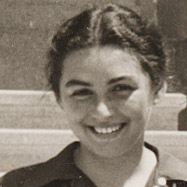
1939, Tel Aviv
|
Sokal, Poland |
Toni Katz was born September 30, 1919 in Sokal, Poland (now Ukraine), the daughter of Leo Katz and Frida Tabak. She came to Gera, Germany, with her family when she was three years old. There her parents owned a store that sold linen and other fabric goods. Toni Katz had to abandon school at the age of 14 due to the rising antisemitism. She then began an apprenticeship in a department store in Gera, but was dismissed when the enterprise was "Aryanized" at the end of 1935. She joined Bar Kochba, a Zionist youth sports association. She came to Jägerslust in the summer of 1938 where she remained until its abrupt end on November 10, 1938, during the so-called November Pogrom (Kristallnacht). She must have made an impression in her group as she was the only young woman mentioned by name by Lilli Dreifuss in her February 1939 letter who described her as being the only "nice girl":
About the events of November, Toni Katz wrote:
After her release from custody, she was able to go back to her home to Gera, only to find that her parents had been deported to Poland during the roundup of Polish Jews on October 28-29. By then a "stateless" Jew, she spent the following months hiding with friends. Most likely due to her having made an impression during her time in the Jägerslust Hachshara as "hardworking and quite smart", she was offered a place on a ship to Palestine. She boarded the Dora, an illegal immigration ship with 500 Jewish refugees in July 1939, landing in Eretz Israel two weeks before the start of WW2. She died in Paris, France, in 2001. Her parents were victims of the Shoah, most probably murdered in Belzec in 1943. Her brother Yitzhack came to Palestine in 1937 with Youth Aliyah. |
|
Paul Katzenberg
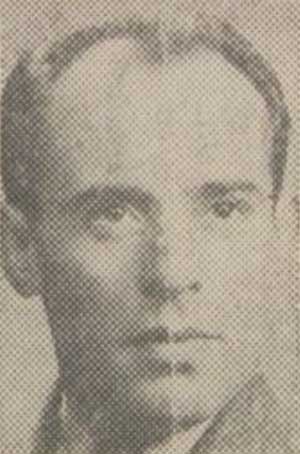
Photo: Dagens Nyheter, 1969 |
Hamborn |
Paul Katzenberg was born June 18, 1909 in Hamborn near Duisburg, the son of Salomon (Shlomo, Salli) Katzenberg, and Ottilie Katzenberg (nee Epstein). He had two sisters, Toni and Lindy. His father died in 1931. Paul Katzenberg completed high school and received vocational training as a wholesale merchant. It is not known when Paul Katzenberg attended the Hachshara in Gut Jägerslust. In September 1938 he married Rosel Adler, from Berlin. He then went to Denmark for further training in the framework of the exchange program. In August 1943, his daughter, Ruth Hanna, was born in Denmark. On October 13, 1943, ahead of the planned mass roundup of Jews in Denmark, Paul Katzenberg, his wife Rosel and their two-month-old baby fled Denmark and reached Sweden aboard a small fishing boat. The family's escape is described in "Passage to Palestine - Young Jews in Denmark, 1932-1945" by Jørgen Hæstrup, p198-202.
According to the immigration form he filled out upon his arrival in Sweden, Paul Katzenberg was an agricultural student. Paul and Rosel Katzenberg had a second daughter, born in 1945. The couple remained in Sweden. Paul Katzenberg died in November 1996 in Stockholm. His mother, Ottilie Katzenberg, was deported to the Theresienstadt Ghetto on July 27, 1942, then to Treblinka on September 19, 1942 where she was murdered. His sisters, Toni Ermann, and Lindy Manheimer, emigrated to Palestine. Sources: |
|
| 1936-1937 |
Paul Katzenstein

|
No further information available. |
|
| 1936-1937 |
Franz Kaufmann
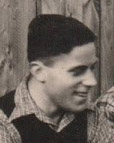
|
Breslau (Wrocław) |
Franz Kaufmann was born November 22, 1916 in Breslau. He was a young dental technician and managed to emigrate directly from Flensburg with the help of the coveted worker certificate to Palestine. (Handwritten note "to Palestine" on municipal notice of departure). Sources: |
| 1936-1937 |
Max Klausner

|
There is one Max Klausner, born in Guben, Germany in 1915 who immigrated to Palestine in April 1937 in the www.archives.gov.il, but no confirmation it is the same individual. Although the dates of birth and immigration suggest a possible match, his photograph is unfortunately too blurry to confirm it is the same person. This person's occupation was fitter, unusual for people who had gone through Hachshara and were typically in agriculture. No further information available. |
|
| 1936-1937 |
Ernie Kopilowski

|
No further information available. |
|
|
Lene Kronertz

|
Lene Kronertz fled to the Netherlands where she was hidden by courageous Dutch famers for the duration of the war. She later remained in the country. Source: Bernd Philipsen |
||
| May 1937 to Aug 1938 |
Frieda Landmann

|
Berlin |
Frieda Landmann was born April 2, 1914* in Berlin, the daughter of Kalman Landmann, a cabinet maker originally from Jaslowiec in Galicia (now Yazlovets, Ukraine), and Marie (Miriam) Landmann, also from Galicia. She had (at least) one sister, Ele (Eleonore?). Frieda Landmann attended the Gut Jägerlust Hachshara from May 25, 1937 to August 31, 1938. From there she went to Denmark for further training in the framework of the exchange program. In November 1940 she was registered in the Denmark Census as living in Kongsted. Two other Jägerlust trainees were also registered at the same location: Regina Woislawski and Erika Dallmann. Frieda married Benno (Benjamin) Ziegler in January 1943. (Originally from Mannheim, Benno Ziegler had been on hachshara in Italy before coming to Denmark where he was a "madrich".) On October 9, 1943, ahead of the planned massed roundup of Jews, Frieda and Benno fled Denmark aboard a motorboat and came to Sweden. According to the immigration file she filled out upon her arrival, she was a clerk. Frieda and Benno came to Eretz Israel on February 1946 and the couple lived in Jerusalem. Frieda's father was incarcerated in Sachsenhausen where he perished on May 20, 1940. (62) Frieda's mother was also a victim of the Holocaust. The fate of her sister Ele Landmann is not known. Sources: *Note: April 2, 1914 is based on Frieda's 1943 immigration form. Other source has March 1913. |
| 1936-1937 |
Eva Lange
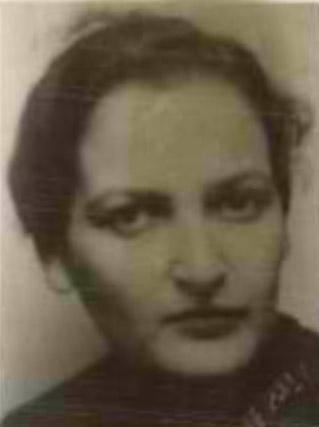
1941
|
Breslau (Wrocław) |
Eva Lange was born October 15 1912 in Brieg, Silesia, Germany (now Brzeg, Poland). She arrived in Palestine with a visa on March 29, 1937. She married Gunter Riesenfeld, another Jägerslust trainee. In Israel, they lived in Kvuzat Massad, near Ein Harod. Other Jägerslust alumni who settled in Kvutzat Massad included David (Adi) Sporn and Hermann Berger. The couple had a daughter, born in 1938. Eva Riesenfeld later emigrated to England. She married George Robert Harkness in a second marriage and the couple had one child born in 1950. Eva Harkness (Lange) died in 2003 in Bedforshire, England. Sources: |
| 1936-1937 |
Gertrud Leiter

|
Oberdorf |
Gertrud Leiter (later Plaut) was born May 22, 1914 in Oberdorf (Bopfingen) in Baden-Württemberg, the daughter of Karl Leiter, a merchant originally from Oberdorf, and Ida Gutmann. She had one sister, Helene. Gertrud married Fritz Plaut, another Flensburg hachshara trainee. She received her immigration visa in Flensburg on May 7, 1937 and arrived in Haifa on September 19, 1937. The couple lived in Kiryat-Haim and had one son Hanan, born in 1938 in Petah Tikva. She later left Israel and emigrated to the USA in the 1950s, as evidenced by a Social Security application submitted in 1953. Gertrud's father was incarcerated in Dachau. Her parents managed to emigrate to the USA, arriving in New York in September 1941. They later lived in Chicago. The fate of her sister Helene is not known. Sources: |
|
Bernhard Lieser

|
Leipzig |
Bernhard Lieser was born May 25, 1918 in Leipzig. According to his 1943 Swedish refugee registration form, he attended primary school, presumably unable to continue his education due to National Socialist persecutions. After leaving Jägerslust, he went to Denmark for further training in the framework of the exchange program. There he attended the Slangerup Agricultural School, along with another Jägerslust trainee, Ferdinand Ehrenberg, as evidence by this testimony ("Unge jøders flugt 1939-1945"):
In October 1943, alerted about the upcoming deportation of Jews by the occupying German forces, more than 7,000 Danish Jews were spirited away to Sweden with the help of the Danish resistance. Bernhard Lieser was among the Jews who fled to Sweden during this rescue operation. He sailed from Sletten, Denmark, aboard a powerboat in the night of October 4, 1943, and arrived in Ven in Sweden the next day. His escape to Sweden means that Bernhard Lieser survived the war. No further information is available. Sources: |
|
| 1936-1937 |
Lina Lilie

|
Frankfurt |
Lina Lilie (nee Hess) was born December 20, 1907 in Offenbach, Darmstadt, Germany. She was married to Ludwig Lilie, another Jägerslust trainee. After Jägerslust, Lina and Ludwig came to Sweden. From there they managed to get to Japan, most likely traveling through Russia via the Trans-Siberian Railway. They then boarded sailed from Yokohama to Seattle, on the West Coast of the USA, where they arrived on October 31, 1940. Ludwig and Lina Lilie later moved to the East Coast and the couple had one son, born in New York in 1943. Lina Lilie died in August 1991 (83), in the Bronx. Sources: |
| 1936-1937 |
Ludwig Lilie

|
Frankfurt |
Ludwig Lilie wa born November 29, 1905 in Seligenstadt, Germany, the son of Gustav Akiba Lilie and Settchen Lilie (born Simon). He had four siblings: Rosel, Herta, Richard, and Alice. Ludwig's father died in June 1924 when Ludwig was 18 years old. Ludwig Lilie was married to Lina Lilie, another Jägerslust trainee. He moved to Frankfurt am Main in January 1937, suggesting that his training had ended by then. Ludwig's and Lina's road to safety followed a long and tortuous path. After leaving Germany they came to Sweden. In September 1940 they were issued new passports in Gothenburg. From there they reached Japan, most likely traveling through Russia via the Trans-Siberian Railway. (It is possible that they were helped by Chiune Sugihara, a Japanese diplomat who provided transit visas Japan for thousands of Jewish refugees. Suggesting that their path was not unique, eight out of 21 "alien passengers" who would sail with them had received new passports in Gothenburg). They then boarded the Heian Maru, a Japanese ocean liner which sailed from Yokohama to Seattle. They finally arrived in the USA on October 31, 1940. At the time of their arrival, Ludwig Lilie's profession was "farm laborer". Ludwig and Lina Lilie later moved to the East Coast and the couple had one son, born in New York in 1943. Ludwig Lilie died January 1998 (92) in the Bronx. Ludwig Lilie's mother, Settchen Lilie, was deported from Darmstadt to the Theresienstadt ghetto on September 27, 1942. From there she was transported to Auschwitz-Birkenau on May 18, 1944 where she was murdered. His sister, Herta Lilie, was deported from Darmstadt to Treblinka on September 30, 1942, where she was murdered. Ludwig's siter Rosel Hersch emigrated to the USA. His brother Richard Lilie emigrated to Israel. The fate of his sister Alice is not known. Sources: |
| ? to Nov 9 1938 |
Karl Lindenberg

|
Berlin |
Karl Lindenberg's name is listed in the "custody book" of the Kiel prison following his arrest during Kristalnacht. Assuming he was then sent to the Sachsenhausen concentration camp like all the other young men from Jägerslust, and was later released at the end of December 1938 after presenting a plan to leave Germany. No further information available. Source: Bernd Philipsen. |
| 1935-1936? |
Erwin Linz
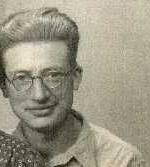
|
Rotenburg an der Fulda |
Erwin Linz (later Ilan) was born November 10, 1914 in Rotenburg an der Fulda, the son of Hermann Linz and Fanny Linz (Plaut). He had one sister, Sophie. His father, Hermann Linz had taken over his father's grain and flour business and expanded it in 1930 with a coffee roasting plant. Erwin Linz attended Jägerslust around 1935. He received an entry permit to Palestine in July 1936 and arrived in Palestine on July 13, 1936. At the time of his application for citizenship in November 1938, he lived in Kfar Yechezkiel where he worked as an agricultural laborer. In Palestine, Erwin Linz was initially involved in an irrigation project on the western edge of the Jordan Valley. In 1945, Erwin and his wife joined the kibbutz Givat Hashlosha, and in 1952 Kibbutz Einat. The couple had (at least) one son, Uri Ilan, born ca 1941. Erwin Linz changed his name to Joseph Ilan Joseph Ilan (Erwin Linz) died in 1998 (age 83) in Bnei Brak. His parents, Hermann and Fanny Linz were deported to the Theresienstadt ghetto in 1942. From there they were deported to Auschwitz and murdered in October 1944. (Other source: deported from Frankfurt to Auschwitz in June 1942.) His sister Sophie Rosenfeld (Linz) was able to escape to England in 1939 where she studied to be a nurse. She later emigrated to San Francisco where she married Kurt Josef Rosenfeld. Note: through his mother Fanny Plaut, Erwin Linz was second cousin with Fritz Plaut, another Flensburg hachshara trainee. It isn't clear whether this is a mere coincidence, or an indication that youngsters were able to attend the same hachsharot based on family ties or preferences. Sources: |
| 1935-1936? |
Lucie Loewald

1941
|
Breslau (Wrocław) |
Lucie Loewald was born June 25, 1912 in Breslau, Germany (now Wrocław, Poland), the daughter of Max Loewald and Margarete (Marga) Gross. She emigrated directly from Flensburg to Palestine with the help of the coveted worker certificate; (handwritten note "to Palestine" on municipal notice of departure). She arrived in Palestine 8 September 1936. She married Erich (Eliahu) Cohn-Biedermann. Her husband had joined the Haganah and was killed in 1939: "Eliahu Cohn-Biedermann, shot by three Arabs on May 10, 1939 while garding the governor's house in the German Colony in Haifa. Eliyahu and his friend, Dov Berad, were killed on the spot." She was a children's nurse, Beth Hatinokoth (WIZO' Baby Home), Jerusalem. Lucie Cohn-Biedermann (Loewald) died in 2001. Sources: |
|
Fritz Löwenstein

|
Fritz Löwenstein stayed in Flensburg and came to Denmark under the same program as Alex Muschinsky. Source: Lars and Peter Muschinsky |
||
| 1936-1937 |
Josef Lustig
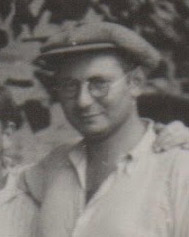
|
Breslau (Wrocław) |
Josef Lustig was born December 19, 1907 in Breslau (now Wrocław, Poland), the son of Gustav Tobias Lustig and Salome Sara Lustig (Rabinersohn or Rabinsohn). After graduating from Gymnasium, Josef joined his father's business, which dealt with import and export of agricultural products, especially eggs. He was an active member of the Blau-Weiss association in Breslau and was for a time chairman of the local chapter. In 1933, he wanted to immigrate to Israel, but the leadership of the association asked him to postpone his immigration, so that the Zionist pioneering activity among the Jewish youth in the city would not suffer. Josef came to Jägerslust in 1936 and, in June 1937, while still a resident of Flensburg, married Friederike Clarfeld (Frederica, Frieda Klarfeld) in Breslau. Although Frieda came to visit him in Jägerslust, it doesn't appear that she ever was a trainee there. After their marriage, Josef and Frieda went to Denmark, where they spent approximately a year in 1938 in a farm in Sjaelland area for further agricultural training. They later received the much-coveted immigration visa to Palestine and, in January 1939, Josef and Frieda arrived in Haifa aboard the SS Champollion, having sailed out of Marseille. The couple settled in Kibbutz Yagur, where Josef's brother Martin (Mordecai) lived. Josef joined the Hagannah, and in 1946, following the Operation Agatha (aka "Black Sabbath") which uncovered one of the main weapons arsenal of the Hagannah in Yagur, was incarcerated in a British detention camp in Rafiah for almost half a year. The Lustigs were lifelong members of Kibbutz Yagur. The couple had two children, a son and a daughter, and six grand-children. Josef Lustig passed away in December 1978 in Kibbutz Yagur. Josef's parents Gustav Tobias and Salome Sara Lustig were murdered in Auschwitz in 1942. Josef's brother Martin and his sister Gisela both emigrated to Israel and survived the war. Josef's younger sister Gisela (Golda) married Werner Brock, another trainee in Jägerslust. Sources: |
| ? to March (?) 1938 |
Siegfried Marcks
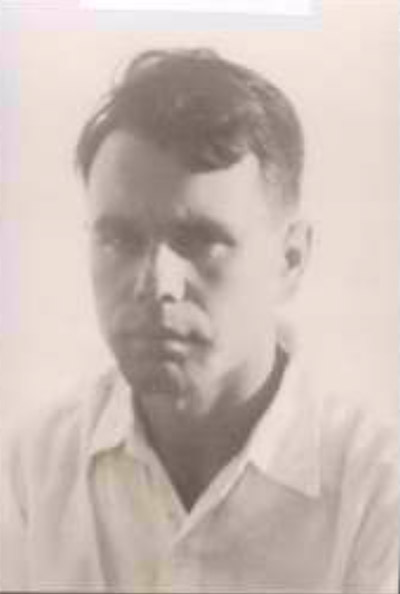
1942
|
Breslau |
Siegfried Marcks was born August 26, 1915 in Breslau, Germany (now Wrocław, Poland), the son of Gustav Marcks and Olga Pick. Siegfried Marcks emigrated directly from Flensburg to Palestine with the help of the coveted worker certificate (handwritten note "to Palestine" on municipal notice of departure), arriving in Palestine on March 14, 1938. At the time of his application for citizenship in Palestine in 1942, he lived in Kibutz Shamir as a laborer and was single. He later changed his name to Eli Marcks. He married Hannah Maria Siegel and the couple had two children. Eli (Siegfried) Marcks died in April 2012 in Arad. His mother, Olga Marcks, was deported from Hannover to the Ravensbrück concentration camp on March 28, 1942, then to Auschwitz, where she was murdered on October 11, 1942. Details about his father's fate are not known. He presumably died (or was murdered) prior to his wife's deportation. Sources: |
| Mar 1937 to July 1938 |
Alex Muschinsky

1947
|
Alex (Alexander Josef) Muschinsky was born August 25, 1917 in Chemnitz, the son of Mendel Muschinsky, a merchant, and Louisa Muschinski, born Schneider. Both parents were originally from Galicia (Poland). Alex had one brother, Gideon. In 1935 Alex and his younger brother Gideon were expelled from school. Gideon left Chemnitz for Palestine, and Alex worked in different garages and workshops, trying to get an education. Alex spent 16 months in Jägerslust, from March 23, 1937 to July 24, 1938. He then left for Denmark mid-October of 1938 and worked as "Madrich" (group leader) for Youth Aliyah groups and as an agricultural worker in various places in Sealand (Sjælland) and Fuen (Fyn) until October 1943. In October 1943, Alex, along with thousands of Danish Jews, fled to Sweden. His escape was organized by the Danish resistance and a Danish police officer from Odense, Fuen. He returned to Denmark in 1945 where he settled permanently. He met his wife Eva in 1947 and had two sons - Lars Jakob in 1948, and Peter in 1952. He was a teacher in arts and crafts, first in a school, and later in a college for social educators. Alex Muschinsky died in October 1994 in Frederiksberg, Denmark. Alex's parents Mendel and Louisa Muschinski were deported to the Polish border in October 1938. After the German invasion they had to move to the Łomża ghetto. They tried without success to get visas for Palestine and America. They were murdered in Auschwitz in January 1943. His brother, Gideon Muschinsky, emigrated to Palestine. Sources: |
|
| July 1938 to Nov 9 1938 |
Regina Nadler

1943
|
Berlin |
Regina Nadler was born on September 27, 1915 in Berlin, the daughter of Salomon (Shlomo) Nadler, a clothing store owner born in Sambor (Austria-Hungary, then Poland since 1918), and Mali Nadler nee Feldmann, a housewife born in Przemysl, Poland. Regina had four siblings: Jonny Yona (1913), Anna (ca 1914), Rosa (ca 1918), and the youngest, Lottchen (1928). The family lived in Berln. There she attended elementary school and trade school. Regina Nadler joined the hachshara in Jägerlust as a housekeeping trainee along with her fiancé Max Woislawski in July 1938. [or: she met Max Woislawski in Jagerslust.] Her training lasted just a few months, ending abruptly in the night of November 9-10, 1938, the so-called November Pogrom. Following that night's events, she was incarcerated in the Flensburg police prison for the night. She was released along with the other young women of the Hachshara and was able to get back home in Berlin. According to the German Minority Census of mid-May 1939, Regina lived with her mother and 3 sisters: Anna, Rosa and 10-year-old Lotthen. She fled to Denmark with Max Woislawski at the end of January 1939. In November 1940, she was registered in the Denmark Census as living in Kongsted. Two other Jägerlust trainees resided at the same location: Frieda Landmann and Erika Dallmann. (Her name also appears in the Denmark Census as residing in Svallerup, a small village in West Zealand.) By then, Regina and Max were married. Their son, Amos Aron, was born in February 1942 in Klampenborg, Denmark. On October 17, 1943, Regina and Max Woislawski fled to Sweden aboard a fishing boat as part of the mass rescue operation of the Jews from Denmark. In 1949 Regina and Max finally came to Israel. She lived in Sha'ar Hefer near Natania. Regina's father, Salomon (Shlomo) Nadler, was deported to Przemysl (other source: Lodz) where he was murdered. Her mother, Mali Nadler, was deported to Treblinka where she was murdered upon her arrival in 1942. Her youngest sister Lotchen was deported to Przemysl (other source; Warsaw, or Lodz.) She vanished in the Holocaust. She was 14. Jonny Yona Nadler was a soldier and was murdered as prisoner of war in Lodz. The fate of her sisters Anna Nadler and Rosa Nadler is not known. Sources: |
| 1935-1937 |
Hanna Nathan

|
Köln |
Johanna Fleischhacker (later Hanna Nathan) was born September 30, 1912, in Hildesheim, Germany. She was married to Herbert Nathan, another Flensburg hachshara trainee. She had a passport issued in Flensburg, November 28, 1935, indicating that she started her training sometime that year. Johanna and her husband arrived in Palestine April 12, 1937 and the couple had one daughter. Johanna later changed her name to Hanna Nathan. Hanna Nathan (née Johanna Fleischhacker) died in Israel in April 1964 at the age of 51. Sources and photo: |
| 1936-1937 |
Herbert Nathan
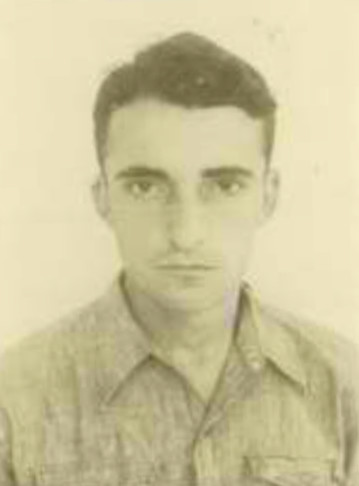
1940 |
Köln |
Herbert Nathan was born February 2, 1914 in Köln, the son of Julius Nathan, a commercial clerk, and Rosalie Rosendahl. He had one brother, Rudolf. The family lived in simple, middle-class circumstances. Herbert and his brother Rudolf attended the municipal Jewish elementary school, then completed a commercial apprenticeship after graduating from school. When the National Socialists took power in early 1933, the family's situation quickly became very difficult, as Julius Nathan and his sons, being Jews, couldn't find work. Herbert and Rudolf joined Jewish youth associations and planned their emigration. Herbert came to Jägerslust in 1936 then went to Hamburg for a few months to complete his training. He was married to Johanna Fleischhacker, another Flensburg hachshara trainee. He was then able to emigrate to Palestine on April 12, 1937 with his wife. At the time of his Application for Palestinian Citizenship in 1940, he lived in Ramot HaShavim and was an agricultural laborer. The couple had one daughter. He later owned a chicken farm. He later married Ada Bermann (born Saul Peyser) in a second marriage. Herbert Nathan died in July 2003 in Ramot HaShavim at the age of 89. Herbert's parents, Julius and Rosalie Nathan, had become increasingly poor and were unable to emigrate for financial reasons and because Rosalie Nathan was ill. Rosalie Nathan died in July 1941 in the Jewish hospital in Ehrenfeld. Julius Nathan, was deported to the Theresienstadt ghetto in the summer/autumn of 1942 and later to Auschwitz where he was murdered. His brother Rudolf was arrested during the pogrom in November 1938 and taken to the Dachau concentration camp. Released shortly thereafter, he emigrated to Denmark soon after. When German troops occupied the country, he fled to Sweden. After the end of the war he returned to Denmark and lived there until his death. Sources: |
| ? to July 1936 |
Hans Oppenheimer

1939
|
Frankfurt am Main |
Hans Oppenheimer was born October 8, 1913 in Frankfurt am Main. He emigrated directly from Flensburg to Palestine with the help of the coveted worker certificate; (handwritten note "to Palestine" on municipal notice of departure). Hans Oppenheimer married Magdalena Felicitas Ferenszi, who may have also been a trainee in Jägerslust. (Her passport was issued in Flensburg on July 6, 1936). The couple came to Palestine on July 22, 1936. They lived in Kibbutz Ashdot Yaakov and Hans Oppenheimer was an agricultural laborer. Sources: |
| July 1937 to Oct 1938 |
Ludwig Heinz Oppenheimer

|
Berlin |
Ludwig Heinz Oppenheimer was born July 24, 1919 in Berlin, the son of Alfred Oppenheimer and Berta Oppenheimer, nee Seelig. Ludwig Oppenheimer arrived in the hachshara from Berlin on August 23, 1937. He left Jägerslust on October 25, 1938 for Frankfurt am Main. He died of pneumonia in the Jewish Hospital of Frankfurt on December 28, 1938 in Frankfurt am Main. Ludwig's parents, Alfred (60) and Bertha Oppenheimer (55), were deported from Berlin to Auschwitz on January 29, 1943 where they were murdered. Sources: |
| 1936-1937 |
Friedel Peterseil
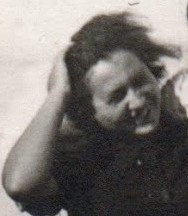
|
Kiel |
Friedel Peterseil was born February 16, 1918 in Kiel, the daughter of Simon (Szymon) Peterseil, and Hudes Herta Biedemann. Her parents were originally from Wiznitz, Bukovina, a small town known for its Hassidic sect (Austria-Hungaria until 1918, Poland, now Vyzhnytsya: Ukraine). Fridel had two siblings, Annie (Chana) and David Salomon. Friedel Peterseil attended school in the city of Kiel, then started to work in 1934 at the age of sixteen to help support her family. She got married in a fictitious marriage (with Martin Loeb Bamberger) to get a certificate and she emigrated to Eretz Israel in 1937. She first lived in Kibbutz Kfar Szold where her brother David lived. She enlisted in the Palmach in 1942 in Company E. Among her other activities, she participated in the surveillance of Etzel and Lehi personnel during the "season". She was released in 1944. She married Mordechai Shkedi (Mandelbaum) and the couple had (at least) two daughters. She lived in Kibbutz Givat Chaim (Ihud). She died in October 2002 in Kibbutz Givat Chaim. Her parents, Szymon (59) and Hudes Peterseil (56) were deported from Hamburg to the Theresienstadt Ghetto on July 29, 1942, then to Auschwitz where they were murdered. Her brother, David Tzur Peterseil emigrated to Palestine in July 1935. Her sister Annie Chana Peterseil also emigrated to Palestine in 1935. Sources: |
| ? to Nov 9 1938 |
Siegbert Pinkus

|
Mrotschen (Posen) |
Siegbert Pinkus was born on 10 April 1921 in Mrotschen, Poland. His name appears in the "custody book" of the Kiel prison, where he was incarcerated following his arrest during Kristallnacht. It is assumed that he was then taken to the Sachsenhausen camp along with all the other young men from Jägerslust and was released at the end of December 1938. After his release, he fled Germany and came to the Netherlands. During the war he was hidden by Dutch farmers in various locations. From Bielefeld he fled to Voorst, then stayed at Hummelo. From April 1941 he lived in Assen, at Javastraat 3, with the J. van Tijn family; from there he moved to the Magnus family at Rolderstraat 54. Siegbert survived the war. He later emigrated with his wife, Betty Pinkus-Cohen (Betje Cohen), to Israel. Sources: |
| 1936-1937 |
Fritz Plaut

|
Fritz (later: Zvi) Plaut was born May 6, 1918 in Frielendorf, Germany, the son of Moses Hirsch Ephraim Plaut and Jettchen Katz-Stiefel. Fritz had six siblings: Walter, Leopold, Heinz (Chaim), Rosie, Ludwig Lutz and (unknown). His father died in 1934 when Fritz was 16 years old. He married Gertrud Leiter, another Flensburg hachshara trainee. He received his immigration visa in Flensburg on May 7, 1937 and arrived in Haifa on September 19, 1937. The couple lived in Kiryat-Haim and had a son in 1938. At the time of his 1947 citizenship application, Fritz was a building labourer. Tzvi (Fritz) Plaut died in April 1985 in Ramat Gan. Note: Fritz Plaut was second cousin with Erwin Linz, another Flensburg hachshara trainee. It isn't clear whether this is a mere coincidence, or an indication that youngsters could manage to attend the same hachsharot based on family ties or preferences. His brother, Ludwig Lutz Plaut, was deported from Berlin to Riga on November 27, 1941 with his wife and children. They were murdered upon their arrival three days later on November 30, 1941. His mother, Jettchen Plaut, emigrated to the USA. His brother Walter emigrated to the USA in 1927. His brother Leopold, and sister Rosie Ottenheimer, also emigrated to the USA. His brother Heinz Chaim Plaut emigrated to Palestine. The fate of his last sibling is not known, but presumably also survived. Sources: |
|
| 1936-1937 |
Günther Riesenfeld

1941
|
Breslau (Wrocław) |
Günther Riesenfeld (later: Zeev Sadeh) was born November 22, 1912 in Breslau (now Wrocław, Poland), the son of Jakob Riesenfeld, a lawer, and Edith Becker. He had two siblings, Renate Anna, and (unknown). Günther married Eva Lange, another Jägerslust trainee. The couple received a visa for Palestine and emigrated on March 29, 1937. The couple had one daughter, born in 1938. At the time of his application for citizenship in 1941, he lived in Kvuzat Massad, near Ein Harod, and was an agricultural laborer. Other Jägerslust alumni who settled in Kvutzat Massad included Hermann (Chaim) Berger and David (Adi) Sporn. Günther Riesenfeld later married Rachel Fraenkel in a second marriage and the couple lived in Kibbutz Ma'Abarot. He adopted the name Zeev Sadeh. According to an article in HaOlam HaZeh, Zeev Sadeh was one of eight Israeli delegates who attended the Bologna Conference for Peace and Justice in the Middle East in 1972 with, among others, Uri Avnery. (Uri Avnery was a Knesset representative and owner of HaOlam HaZeh. Originally a member of the right-wing Irgun, he later became a left-wing peace activist.) Zeev Sadeh (Günther Riesenfeld) died in June 1996 in Kibbutz Ma'Abarot. His parents and his sister, Renate Anna Carr, emigrated to England. Sources: Further Information |
| ? to Nov 9 1938 |
Heinz Robinsohn

|
Hamburg |
Listed in the custody register of the Kiel prison, following his arrest during Kristallnacht. Assuming was then sent to the Sachsenhausen concentration camp, along with the other young men from Jägerslust, and was later released at the end of December 1938 after presenting a plan to leave Germany. No further information available. |
| 1934?-1936 |
Werner Rosenbaum
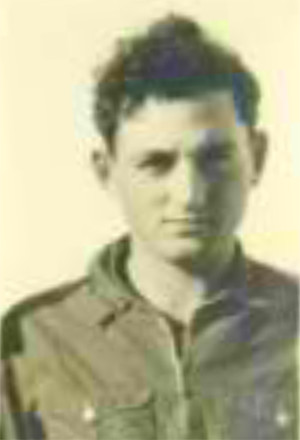
1940
|
Thorn |
Werner Rosenbaum was born December 2, 1912 in Wesel, Germany, the son of Isidor Isaak Rosenbaum and Erika Rosenbaum (Obermeyer). His father was a wealthy merchant and Werner attended secondary school ("Realschule"). He had one sister, Edith. He later worked in a trading house. Werner joined the Hechalutz movement in 1934 then came to the Jägerslust Hachsharah for agricultural training. There he met his future wife Hildegard Bukofzer, another Jägerslust trainee. Werner and Hildegard were married in Flensburg in 1936. They managed to emigrate directly from Flensburg with the help of the coveted worker certificate to Palestine (handwritten note "to Palestine" on municipal notice of departure). Werner and Hildegard Rosenbaum entered Palestine July 13, 1936. At the time of their 1940 citizen application, they lived in kibbutz Ashdot Yaakov and had a daughter, Myriam, born 1937 in Tiberias. Werner's occupation was listed as farmer. Werner Rosenbaum participated in battles in Tel Katzir during the War of Independence. Werner Rosenbaum died in November 1979 (66), in Kibbutz Ashdot Ya'akov. His father, Isidor Isaak Rosenbaum, was murdered in Auschwitz on September 21, 1942 (66). His mother, Erika Rosenbaum (Obermeyer), was murdered in the Riga ghetto in December 1941 (64). His sister, Edith Bauman, survived the war in the Netherlands. Sources: |
| ? to 1936 |
Hildegard Rosenbaum
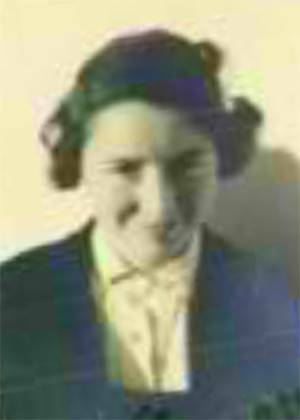
1940
|
Essen |
Hildegard Rosenbaum, nee Bukofzer, was born February 5, 1911 in Essen, the daughter of Samuel Bukofzer and Karoline Bukofzer (Levy). Her father died in 1916 as a soldier fighting for Germany in the Battle of the Somme in France. Hildegard was five years old. Hildegard joined HeChalutz in 1934 and came to Jägerslust for her hachsharah. There she met Werner Rosenbaum, another traineed, in 1935. Both of them worked in the barn. They were married in 1936 in Flensburg, and they managed to emigrate directly from Flensburg with the help of the coveted worker certificate to Palestine; (handwritten note "to Palestine" on municipal notice of departure)." Hildegard and Werner Rosenbaum arrived in Palestine July 13, 1936. At the time of their application for citizenship in 1940, the couple lived in Kibbutz Ashdot Yaakov and had one daughter, Myriam, born in 1937 in Tiberias. The couple would have three children. Hildegard Rosenbaum died in Kibbutz Ashdot Ya'akov in November 2004, at the age of 93. Hildegard's mother, Karoline Bukofzer, died in the Lodz Ghetto in March 1942. Sources: |
| ? to Nov 9 1938 |
Heinrich Rosenberg

|
Thorn |
Heinrich Rosenberg's name is listed in the custody register of the Kiel prison, following his arrest during Kristallnacht. Assuming he was then sent to the Sachsenhausen concentration camp together with all the young men from Jägerslust, and was later released at the end of December 1938 after presenting a plan to leave Germany. |
| ? to 1938 |
Hans Rosenfeld
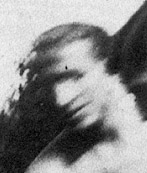
|
Hans Rosenfeld attended Jägerslust in 1938, as documented on a photograph with Max Woislawski and Siegbert Pinkpus, but he must have left before the November Pogrom as his name is not listed in the Kiel prison custody register. This may be the young trainee named Hans mentioned by Anne Dreifuss in her letter dated February 1939: "Hans, our shoemaker, twenty-four years old and handsome". Hans Rosenfeld survived the war as he is mentioned in connection with the compensation procedure for the Wolff family. |
|
| ? to Nov 9 1938 |
Siegfried Rosenthal

1944
|
Kettig bei Koblenz |
Siegfried Rosenthal was born November 25, 1918 in Kettig, Germany, the son of Siegfried Rosenthal and Berta Schnitz. His father died in WW1 on October 25, 1918, one month before his son's birth. Nothing is known about Siegfried's early life or when he joined the Hachshara in Jägerslust. Siegfried Rosenthal's name appears in the "custody book" of the Kiel prison, indicating that he attended Jägerslust until Kristallnacht. Assuming he was then sent to the Sachsenhausen concentration camp, along with the other young men from Jägerslust, and was later released at the end of December 1938 after presenting a plan to leave Germany. Siegfried Rosenthal later fled to the Netherlands. He joined the Werkdorp Wieringen and met there with Heinrich Max Spittel, another former trainee from Jägerlust. Siegfried Rosenthal then teamed up with Heinz Meyerstein to find an escape route together.
On September 21, 1944, Siegfried Rosenthal received a Certificate of Identity from the British Consulate in Madrid. He arrived in Palestine less than two months later, on November 14. He applied for citizenship in 1946. At the time he lived in Kibbutz Kedma and his profession was agriculturist. Siegfried Rosenthal died in 1973 in Israel. Sources: |
| 1938 to Nov 9 1938 |
Samuel Rotstein

1944
|
Holzweißig / Saxony-Anhalt |
Samuel (Sam) Rotstein was born March 19, 1920 in Holzweissig, the son of Abraham Rotstein, a merchant, and Ella Edie Priesel. His father was from Lithuania and his mother came from Wierzbowce, Poland. He had one brother, Hermann Leon. In 1926 Samuel started primary school. In the same year his little brother Hermann Leon was born and in 1929 the family moved to Bitterfeld. After completing "Mittelschule", Samuel learned the trade of plumber in a work and apprenticeship training. He was a member of the Zionist Movement and came to the Hachshara in Flensburg in 1938 in preparation for his emigration to Palestine. He was arrested during Kristallnacht (November 9, 1938), and was taken to the Kiel prison. He was then transported to the Sachsenhausen concentration camp along with the other young men from Jägerslust. He was released some time later with the help of the Zionist Movement and was taken to the Netherlands. In the Netherlands, Sam first worked with a farmer in Hengelo. He then decided to switch profession and trained with a blacksmith in Epe. In 1942, after receiving a notification to report to a labor camp, he went into hiding in Zalk with a distant relative of the blacksmith from Epe. There he met his future wife, Klaasje van den Brink. Samuel and Klaasje were married in July 1946 and the couple had two children. They lived in Zalk, a small village. His wife later became known as Klazien uit Zalk, a herbalist and best-selling author. Sam Rotstein died in June 2007 in Zalk, Netherlands. Sam's parents, Abraham Rotstein (52) and Ella Edie Rotstein (50), were deported from Berlin to Auschwitz on November 29, 1942 where they were murdered. His brother Herman left for England in 1938 with one of the Kindertransports and lived with a foster family. Sources: |
| ? to Nov 9 1938 |
Heinrich Spittel
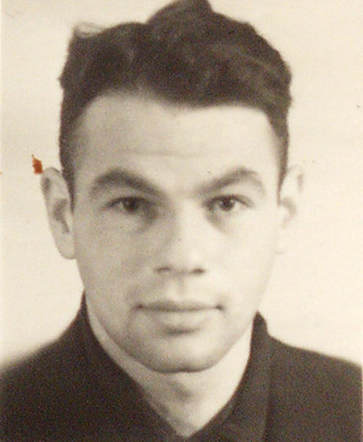
|
Berlin |
Heinrich (Heinz) Max Spittel was born February 27 1918 in Eisenach, the son of Heinrich Spittel and Gertrud Nachmann. His father was killed while fighting for Germany in the First World War in December 1917, less than three months before his son's birth, explaining why his son carried his father's name. His mother remained a widow for several years, before marrying her husband's brother, Max Spittel, and they moved to Berlin. He joined the Zionist pioneering movement Habonim and met Charlotte (Lotte) Wald at a meeting of the organization in 1935. He then came to Jägerslust to prepare for emigration along with Lotte Wald. He was briefly mentioned by Lili Dreyfus in her February 5 letter: "Heini or Sputz, [...] he's engaged to a girl from Bochum." His training ended abruptly with the assault on Jägerslust in the night of November 9-10, 1938, during the so-called November Pogrom. He was then incarcerated in Sachsenhausen, from where he was released on January 27, 1939. He then fled to the Netherlands on February 15, 1939, (presumably) with Lotte Wald. Heinrich's time in the Netherlands is described in the thorough research from www.werkdorpwieringermeer.nl:
According to his wife's testimony, he was a "madrich" (guide) in Arnhem. In the fall of 1942, Heinrich and Lotte started to discuss the possibility of going underground. Before they could implement a plan, they were arrested and sent to the Westerbork camp during the roundup of Jews in Arnhem on December 11, 1942. They remained there for about ten months, then were transported to Auschwitz on September 16, 1943. Heinrich was sent to Buna-Monowitz (Auschwitz III), the synthetic rubber factory of IG-Farben. In August 1944 the factory was bombed by the British and the forced laborers, including Heinrich, were transferred to the Natzweiler-Struthof camp in October 1944, where slave labourers worked in granite quarries. With the American army approaching, the prisoners were evacuated to Buchenwald on January 1, 1945. In March 1945, with the advancing allies closing in, they were transferred to Bergen-Belsen. Heinrich Max Spittel was among the prisoners evacuated to Bergen-Belsen, where he survived until the liberation of the camp by the British troops on April 15. Weakened by his long incarceration, Heinrich Max Spittel died ten days after the liberation of the camp on April 25, 1945. Heinrich Max Spittel's mother, Gertrud Spittel, was murdered in Auschwitz on January 29, 1943. Sources: |
| 1936-1937 |
Adi Sporn

|
Bochum |
David ("Adi") Sporn was born October 8, 1918 in Bochum, the son of Jakob and Sarah Sporn. His father, a merchant originally from Galicia, presumably also acted as prayer leader for the Eastern Jewish Community in Bochum, which used the "small synagogue", an extension of the Jewish school, as a prayer room. The inscription on his tombstone calls him "Rav" (Rabbi): "A man, pure and upright and god-fearing, our teacher and master Jaakow Sporn". He had two siblings, Yehuda and Ferdi. David's father died in January 1927 when David was 8 years old. Although born in Germany, as the son of parents from Galicia, David Sporn was a Polish citizen, as evidenced by his Polish passport issued in Bochum in 1935. David Sporn came to Palestine on February 28, 1938, presumbaly as a legal immigrant as he was able to successfully apply for naturalization in 1940 (i.e. before the 1941 which allowed illegal immigrants to acquire citizenship after having served in the British Army). At the time of his application for naturalization in September 1940, he resided in Kvusat Massat, near Ein Harod, was an ;"agricultural labourer", and was single. David Sporn married Ruth Nathan and the couple had four children. David "Adi" Sporn died in Kibbutz Kfar Ruppin. His brother, Yehuda Sporn, emigrated to Palestine. The fate of Ferdi Sporn is not known, neither is the fate of his mother, Sarah Sporn. Sources: |
| 1936-1937 |
Joseph (Seppl) Sternschein

|
Bayern |
No further information available. |
|
Liselotte Studinski (Levy)
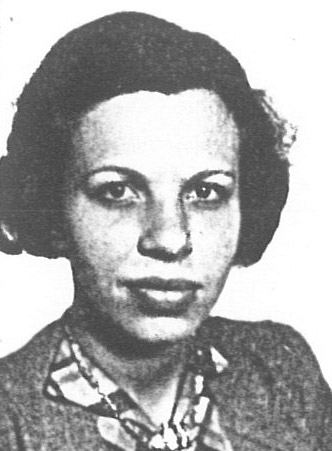
1943
|
Liselotte (Lilo) Studinski (née Levy) was born December 4, 1918 in Berlin. According to Peter Muschinsky, she stayed in Flensburg with her husband Martin Studinski. (Because Liselotte and Martin Studinski were married in 1939 - after the end of the Jägerslust Hachshara, she must have been there as a trainee under her maiden name, and Peter Muschinski's statement must be read as "her future husband". It is possible that Liselotte and Martin met in the Hachshara.) Liselotte and Martin left Germany and came to Denmark in 1939 under the same program as Alex Muschinsky. Liselotte and Martin then fled Denmark ahead of the German roundup and came to Sweden as refugees on September 22, 1943, where they remained until June 1945. The couple returned to Denmark after the end of the war and lived in Copenhagen. In October 1958, they applied for Danish citizenship. At the time, Liselotte was an after-school teacher. The couple had two children. Liselotte Studinsky died in June 1991, aged 72, in Copenhagen. Sources: |
||
|
Martin Studinski
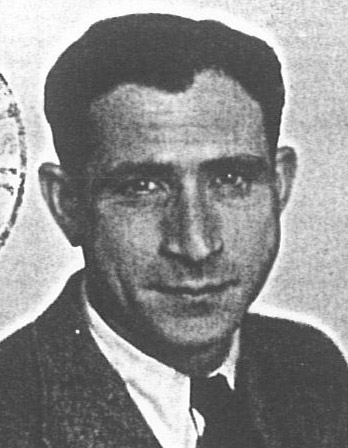
1943 |
Martin Studinski was born February 8, 1914 in Culm, West Prussia (now Chełmno, Poland), the son of Lesser Leo Studinski (born in Czersk, West Prussia) and Ella Simon*, the widow of Dr. Rabbi Schindler*. Martin had one sister, Dorothea*. It can be assumed that the Studinski family left Culm after it was incorporated into the new Polish state in January 1920 in order to remain in Germany. Before coming to Flensburg, Martin Studinski resided in Stuttgart. Martin Studinski came to the Jägerslust Hachshara where he (presumably) met his future wife, Liselotte Levy. They would later marry in 1939. Martin and Liselotte came to Denmark in 1939 under the same program as Alex Muschinsky. They later fled Denmark and came to Sweden as refugees on September 22, 1943, where they remained until June 1945. According to Studinski's 1943 "Application for Alien's Passport", Martin Studinski was a butcher and a gardener. This suggests that he may originally have trained as a butcher, possibly coming from a family in the meat business, then acquired gardening skills in hachshara. On his application, he declared he was looking for work as a gardener. He was by then "stateless", his German passport having expired in January 1942. His last place of residence in Denmark was Birkerød, a town near Copenhagen. Martin and Lieselotte returned to Denmark after the end of the war and lived in Copenhagen. In October 1958, they applied for Danish citizenship. At the time, Martin Studinski was a sausage maker. His name was listed as Julius Martin Studinski. The couple had two children. Martin's mother Ella was murdered in Auschwitz on January 16, 1942. Martin's father, Lesser Leo Studinski, died on January 6 1942 in Berlin. His sister, Dorothea Artelt, emigrated to England before the war where she was a nurse. She and her husband Bruno Artelt, a non-Jewish German member of the Communist Party who had been arrested by the Gestapo in 1936 for his political activities, returned to Germany after the war. Sources: * Details about the family are somewhat convoluted and inconsistent. Based on the 1939 German Minority Census, his mother may have been named Sara, and Ella may have been the name of a second sister. Some sources have his mother Ella being born in Chicago, and being the widow of a Rabbi Schindler. |
||
| 1936-1937 |
Berta Tokajer
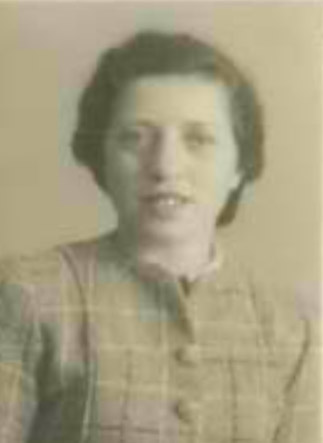
1940
|
Modrzejow, Poland |
Berta Tokajer was born 10 June 1907 in Modrzejow, Poland. She lived in Mainz before coming to the the Jägerslust hachshara. She registered at the Flensburg police headquarters on June 26, 1937 for a yearly extension of her residence permit for her Foreigner Passport ("Fremdenpass"). She married Hans Edelstein on February 16, 1938. She received an immigration visa and arrived in Palestine in March 1938. Berta Edelstein's German Foreigner Passport provides a record of the tortuous path she had to take in order to reach Palestine. She first left her hometown Mainz and traveled to Stuttgart where she registered her marriage (15.2.1938). From there, she traveled to Berlin and went to the British Consulate to receive her visa for Palestine six days later (21.2.1938). Next, she went to Frankfurt, where she obtained transit visas for Austria and Italy from their respective consulates the following week (28.2.1938). The next day, she crossed the border in Salzburg, Austria (1.3.1938), then one day later embarked in Trieste, Italy (2.3.1938), finally reaching Haifa after five days at sea (7.3.1938). Berta husband, Hanan (Hans) Edelstein, recruited into the air service of the Hagana, was seriously injured during the first Egyptian air bombardment of Tel Aviv and died on May 15, 1948, the day after the establishment of the state of Israel. Sources: |
| Nov 1937 to Nov 9 1938 |
Charlotte (Lotte) Wald

|
Bochum |
Sophie Charlotte (Lotte) Wald (later Nira Schnurmann) was born in Bochum, Germany, February 17, 1916 the daughter of Richard Wald and Isabella (Ilse, Elsa) Willstaedt. Her father was an artist painter and decorator who had fought with distinction for Germany during WW1. Her mother was a hatter and her parents ran a successful hat design and production workshop in their home. She had two brothers, Carl Heinz and Hans Gunter. As a child she first attended elementary school, then attended a Jewish school. As a teenager, she joined the Socialist youth movement "The Red Falcons". In 1935 she joined the Zionist pioneering movement Habonim in Bochum, where she was a sports instructor for children.
In November 1937, despite her parents' opposition, Lotte came to the Hachshara in Flensburg. There she received her Aliyah training within the framework of Hechalutz until November 1938. There she met her first husband Heinrich (Heini) Spittel.
'Stam Chalutzim' ('סתם חלוצים') were pioneers with no prior experience with youth groups. Indeed, while a few Jägerslust interns came from Habonim or Hechalutz, it seems that most of them were not affiliated with any pioneer group.
According to Lotte Wald's recollections, the deportation of Polish Jews did not reach Jägerslust:
The next momentous event was the November Pogrom (Kristallnacht). This time, Jägerslust would not be spared.
Following the November Pogrom (Kristallnacht), Lotte was incarcerated for one day in the Flensburg jail.
Following her release, Lotte Wald came to the Netherlands in February 1939 with Heinrich Spittel. There she pursued individual Aliyah training with Hechalutz. She worked for farmers in several places together with Heini Spittel. From May 1940 to June 1941, she continued her Aliyah training in Amsterdam and worked at a vegetarian restaurant. From June 1941 to December 1942, she pursued individual Aliyah training in Arnhem with Heini Spittel and the couple married in February 1942. Lotte and her husband attempted to hide, unsuccessfully, and she was arrested during the roundup of Jews in Arnhem. She was incarcerated in the Westerbork camp on December 11, 1942. She was then deported to Auschwitz on September 16, 1943. In the summer of 1944, Lotte was transfered to Birkenau. She was then transfered to Bergen-Belsen in November-December 1944, and finally in January 1945 to the Salzwedel concentration camp for forced labor in an ammunitions factory. She survived and, following the camp liberation, she returned to the Netherlands on April 28, 1945. From there she moved to France and worked with the organizers of the illegal immigration. She boarded the illegal immigration ship "Tel Hai" in Marseilles on March 17th 1946. The ship was intercepted by the British and was towed to Haifa. After two weeks in the Atlit camp, she joined the members of Kibbutz Galed. She later married Hans Meir Schnurmann. (Hans Schnurmann had taken part in a rescue operation that had brought 60 Jewish refugee children from Sweden to Palestine in March 1941). The couple had three children. She changed her name to Nira Schnurmann. Nira Schnurmann (Lotte Wald) died in November 2012 in Kibbutz Galed, aged 96. Lotte's father, Richard Wald, was deported from Dortmund to the Theresienstadt Ghetto on July 29, 1942 where he was murdered on August 21, 1942 (67). Her mother, Isabella (Ilse) Wald, was deported from Dortmund to the Zamość Ghetto on April 30, 1942. From there she was transported to the Sobibor death camp where she was murdered. Her first husband, Heinrich (Heini) Spittel, died a few days after the liberation of Bergen-Belsen in April 1945, at the age of 27. Her two brothers emigrated before the war. Carl Heinz (later: Carlos Enrique) Wald emigrated to Uruguay, then later to Argentina. Hans Gunter (later: Danny) emigrated to Eretz Israel. Sources: Further Reading: |
| March 1936 to July 1937 |
Ernestine (Erna) Weinert
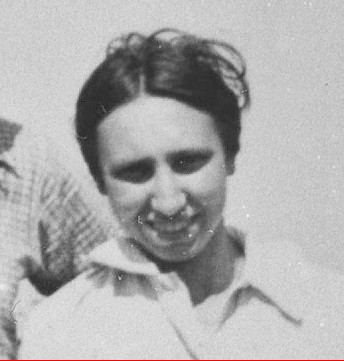
|
Breslau (Wrocław) |
Erna Weinert was born September 23, 1917 in Breslau, Germany (now Wroclaw, Poland). Born in a Catholic family and christened at the age of 4, she was raised by her Jewish aunt Rosa Klammer. At the age of 14 she converted to Judaism. She arrived from Breslau on March 19, 1936 and joined the Hachshara training program in Jägerslust as an agricultural and domestic trainee. There she met her future husband, Richard Hausmann. Together, they left Jägerslust in July 1937. After a stopover with farmers in Meiningen, Thuringia, they escaped to Sweden, then Denmark, then to the USA where they emigrated in 1950. Erna Hausmann died in October 2008 in Tobyhanna, Pennsylvania, USA. |
| July 1937 to Nov 9 1938 |
Max Woislawski
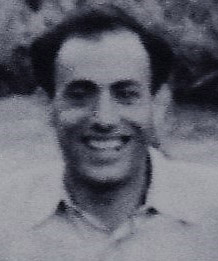
|
Grajewo, Poland |
Max Woislawski was born February 1, 1913 in Grajewo, Poland. He attended the Jägerslust hachshara agricultural training from July 1937 to November 9, 1938. He was joined there by his fiancee, Regina Nadler. Max Woislawski was arrested during the November 9 pogrom and taken to the Kiel jail. He was then incarcerated in the Sachsenhausen concentration camp, from where he was released mid-December 1938 after providing assurance that he would leave Germany. At the end of January 1939, Max Woislawski and Regina Nadler came to Denmark. There Max received further agricultural training within the framework of the exchange program. In November 1940, the couple were registered in Svallerup, a small village in West Zealand. By then, they were married and Max was a farm worker. Their son, Amos Aron, was born in February 1942 in Klampenborg, Denmark. Max and Regina fled Denmark and came to Sweden aboard a fishing boat on October 17, 1943, as part of the mass rescue operation of the Jews from Denmark. According to the refugee registrations form the couple filled out upon their arrival in Sweden, the family was destiture and Max declared having only 10 Danish Krone - equivalent to a half a day of a worker's wage. Max and Regina Woislawski immigrated to Israel in 1949. They lived in Sha'ar Hefer near Natania. Max and Regina Woislawsky's great-granddaughter was murdered during the October 7, 2023 terrorist attack. A resident of Beit Yitzhak, she was 24 years old. Sources: |
| 1936-1937 |
Ben ?
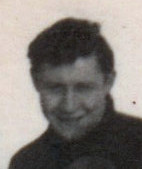
|
From a January 1937 photo caption. No further information available. |
|
| 1936-1937 |
Oscar ?

|
No further information available. |
|
| 1938 |
"Bubchen" ?

|
Mentioned by Anne Dreifuss in a letter dated February 1939: "Bubchen [...] was our youngest, 17 years old and very cute! I've never seen anything so polite. He was very handsome. [He] was very funny, sang all the songs with wrong lyrics and wrong melody. He spoke every word with the ending —chen, he was from East Prussia, played a great harmonica and was engaged and is now married... a very nice boy...". |
|
| 1938 |
Hannibal ?

|
Mentioned by Anne Dreifuss in a letter dated February 1939: "Hannibal, our Goldilocks, had red hair and was our weather prophet. When the curls were out, the sun was shining.". |
|
| 1938 |
Hermann ?

|
Mentioned by Anne Dreifuss in a letter dated February 1939: "Hermann was the eldest, 30 years old. He went to Sweden and is now in Palestine. He spoke when there was something to say, but otherwise held no special position. He was very nice.". |
|
| 1938 |
Lutz ?

|
Mentioned by Anne Dreifuss in a letter dated February 1939: "Lutz, 18 years old", friend of Heinrich Spittel. |
|
| 1938 |
Mendel ?

|
Mentioned by Anne Dreifuss in a letter dated February 1939: "Mendel was a great kid who could light a fire! He always babbled on about camaraderie, that's why his nickname was comrade. Now he is in Eretz Israel at the technical center.". |
|
| 1938 |
Rischer ?

|
Mentioned by Anne Dreifuss in a letter dated February 1939: "Rischer was laughable. He was small and thin and had a long nose. [He] always had to discuss, often about the most impossible things. ". |
|
| 1938 |
Schah ?

|
Mentioned by Anne Dreifuss in a letter dated February 1939: "Schah was our nightingale, he had a beautiful voice!". |
|
| 1938 |
Unnamed boy

|
Mentioned by Anne Dreifuss in a letter dated February 1939: "A boy had something left on his arm from a bike accident. He did our bookkeeping, besides being the most diligent and one of the nicest.". |
|
| 1938 |
Two unnamed brothers

|
Two unnamed brothers are mentioned by Anne Dreifuss in a letter dated February 1939: "We also had two brothers. Terribly vain and conceited, the rest of us just never knew what for. They were very unpopular. But the older one had a very beautiful voice.". The only two brothers known by name are the Berger brothers, however this most likely refers to other siblings as Hermann Berger left at the end of 1937. No other brothers are known to have attended the Hachshara in 1938. |
- Extra Special Thanks:
- Bernd Philipsen, without whom this page would not exist. Most of the content on this page is from his book "Jägerslust". In addition to sharing a copy of the original text and allowing me to use it, he kindly shared much additional content not included in his book, including the list of chalutzim who attended Jägerslust and biographical details about a number of trainees.
- Special Thanks to the descendants of Jägerslust trainees who shared information:
- Eric Hausmann, who generously shared a collection of 27 photographs his grandfather, Richard Hausmann, took during his stay in Jägerslust in 1936-1937.
- Lars and Peter Muschinsky, who shared the story of their father Alex Muschinsky and provided information on several other trainees.
- Rauni and Shimon Lustig, who shared the story of Shimon's father Josef Lustig, along with several photographs.
- Sharon Reshef and Emmanuel Cheim, granddaughter and son of Gerhard and Dora Cheim.
- Ora Benami, the daughter of Nirah Schnurmann (Lotte Wald), who shared her mother's memoir. (January 2024)
- Special Thanks to the following researchers:
- Franz-Josef Wittstamm whose research and help contributed to the biographies of five Jägerslust interns.
- Dörte Hein from the Bochum Archives (Stadtarchiv - Bochumer Zentrum für Stadtgeschichte), for sharing the newsletter containing the letter from Anna and Lilli Dreifuss.
- Verena Buser for sharing the 1935 Gestapo report on Jägerslust.
- Sources and References
- "Jägerslust" : Gutshof, Kibbuz, Flüchtlingslager, Militär-Areal. Gesellschaft für Flensburger Stadtgeschichte, 2008.
- Flensburgs Kibbuz am Rand der Stadt. (05.07.2015 article) .
- Additional Sources
- "Unge jøders flugt 1939-1945" 2018.
- Letter of the sisters Lilly and Anne Dreifuss in issue 7 of the newsletter "Mitteilungsblattes des Bochumer Bürgervereins Erinnern für die Zukunft". The newsletter is kept in our library under the archive signature ZK 163. download.bochum.de
- Additional Reading
- Gemeinschaft in Bildern: Jüdische Jugendbewegung und zionistische Erziehungspraxis in Deutschland und Palästina/Israel. Wallstein Verlag, Göttingen 2009.
